

Connecting Innovation to Purpose Corporate Presentation March 2023 NASDAQ: CRBP • CorbusPharma.com • @CorbusPharma Exhibit 99.2
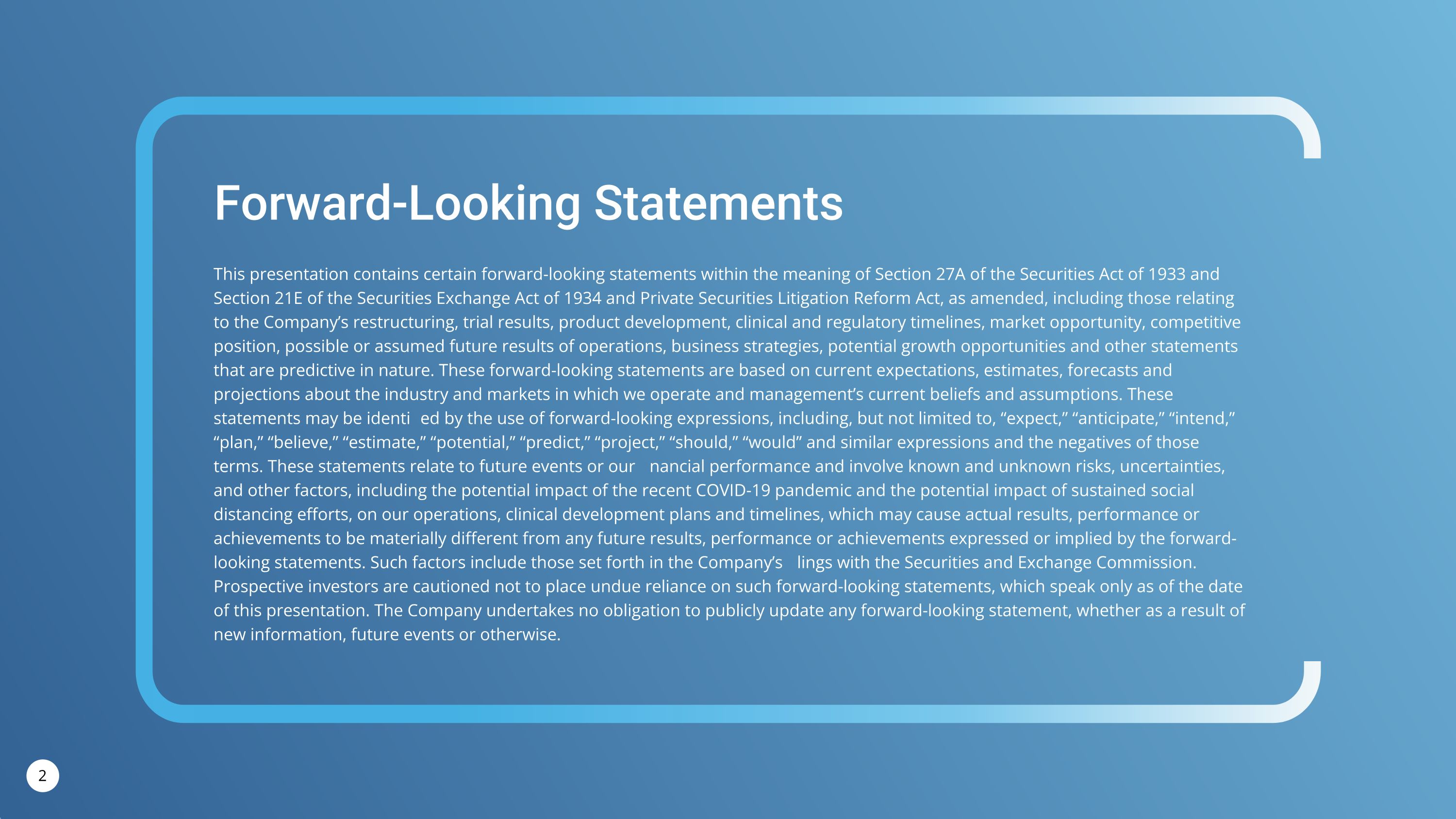
Forward-Looking Statements This presentation contains certain forward-looking statements within the meaning of Section 27A of the Securities Act of 1933 and Section 21E of the Securities Exchange Act of 1934 and Private Securities Litigation Reform Act, as amended, including those relating to the Company’s restructuring, trial results, product development, clinical and regulatory timelines, market opportunity, competitive position, possible or assumed future results of operations, business strategies, potential growth opportunities and other statements that are predictive in nature. These forward-looking statements are based on current expectations, estimates, forecasts and projections about the industry and markets in which we operate and management’s current beliefs and assumptions. These statements may be identified by the use of forward-looking expressions, including, but not limited to, “expect,” “anticipate,” “intend,” “plan,” “believe,” “estimate,” “potential,” “predict,” “project,” “should,” “would” and similar expressions and the negatives of those terms. These statements relate to future events or our financial performance and involve known and unknown risks, uncertainties, and other factors, including the potential impact of the recent COVID-19 pandemic and the potential impact of sustained social distancing efforts, on our operations, clinical development plans and timelines, which may cause actual results, performance or achievements to be materially different from any future results, performance or achievements expressed or implied by the forward-looking statements. Such factors include those set forth in the Company’s filings with the Securities and Exchange Commission. Prospective investors are cautioned not to place undue reliance on such forward-looking statements, which speak only as of the date of this presentation. The Company undertakes no obligation to publicly update any forward-looking statement, whether as a result of new information, future events or otherwise.

Introducing the new Corbus Pharmaceuticals Norwood, MA (Boston area) NASDAQ: CRBP Precision oncology + differentiated assets Established targets enhance probability of success Multiple catalysts in 2023 – 2024
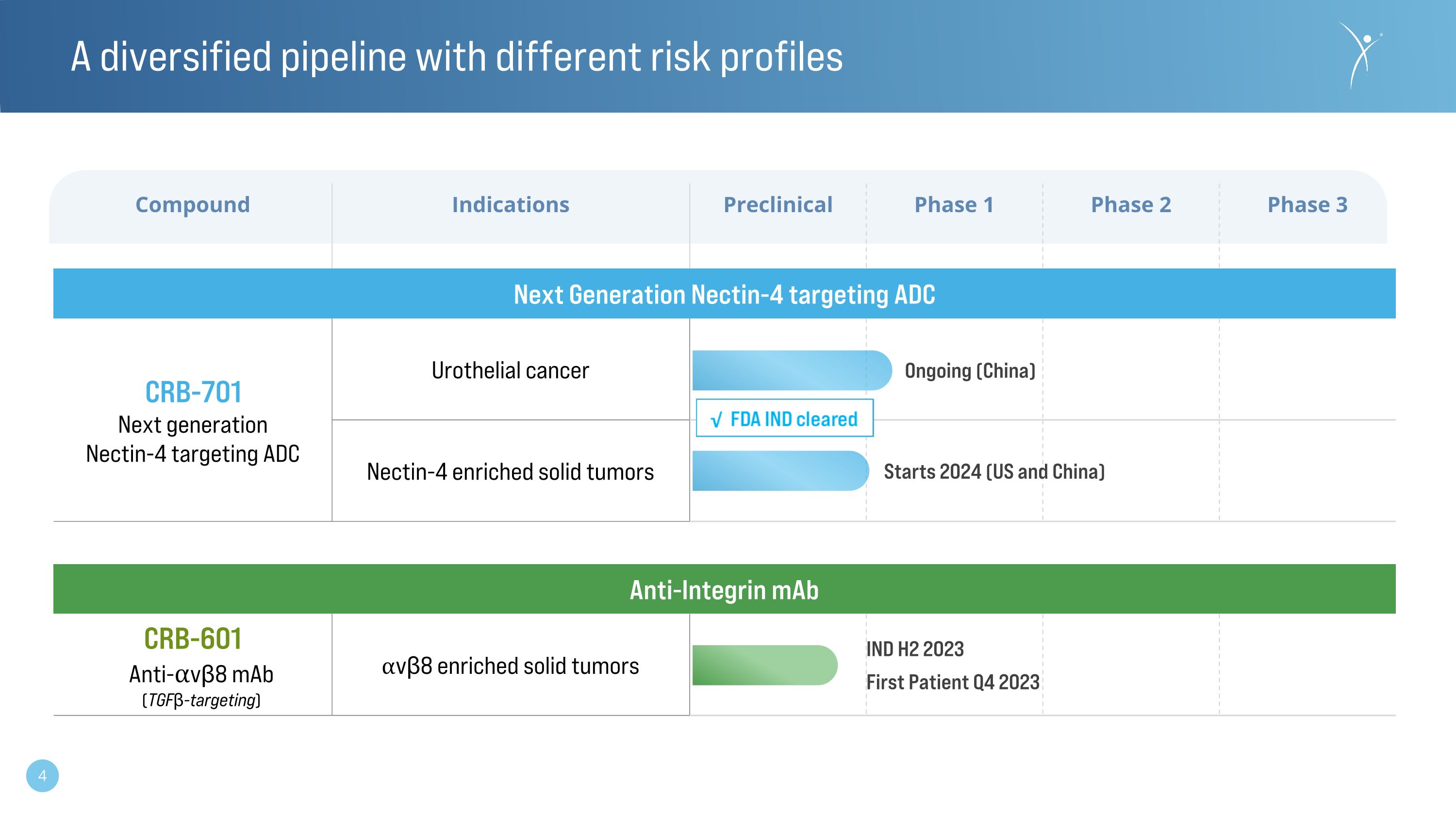
Compound Indications Preclinical Phase 1 Phase 2 Phase 3 Next Generation Nectin-4 targeting ADC CRB-701 Next generation Nectin-4 targeting ADC Urothelial cancer Nectin-4 enriched solid tumors Anti-Integrin mAb CRB-601 Anti-⍺vβ8 mAb (TGFβ-targeting) ⍺vβ8 enriched solid tumors IND H2 2023 First Patient Q4 2023 A diversified pipeline with different risk profiles Ongoing (China) Starts 2024 (US and China)
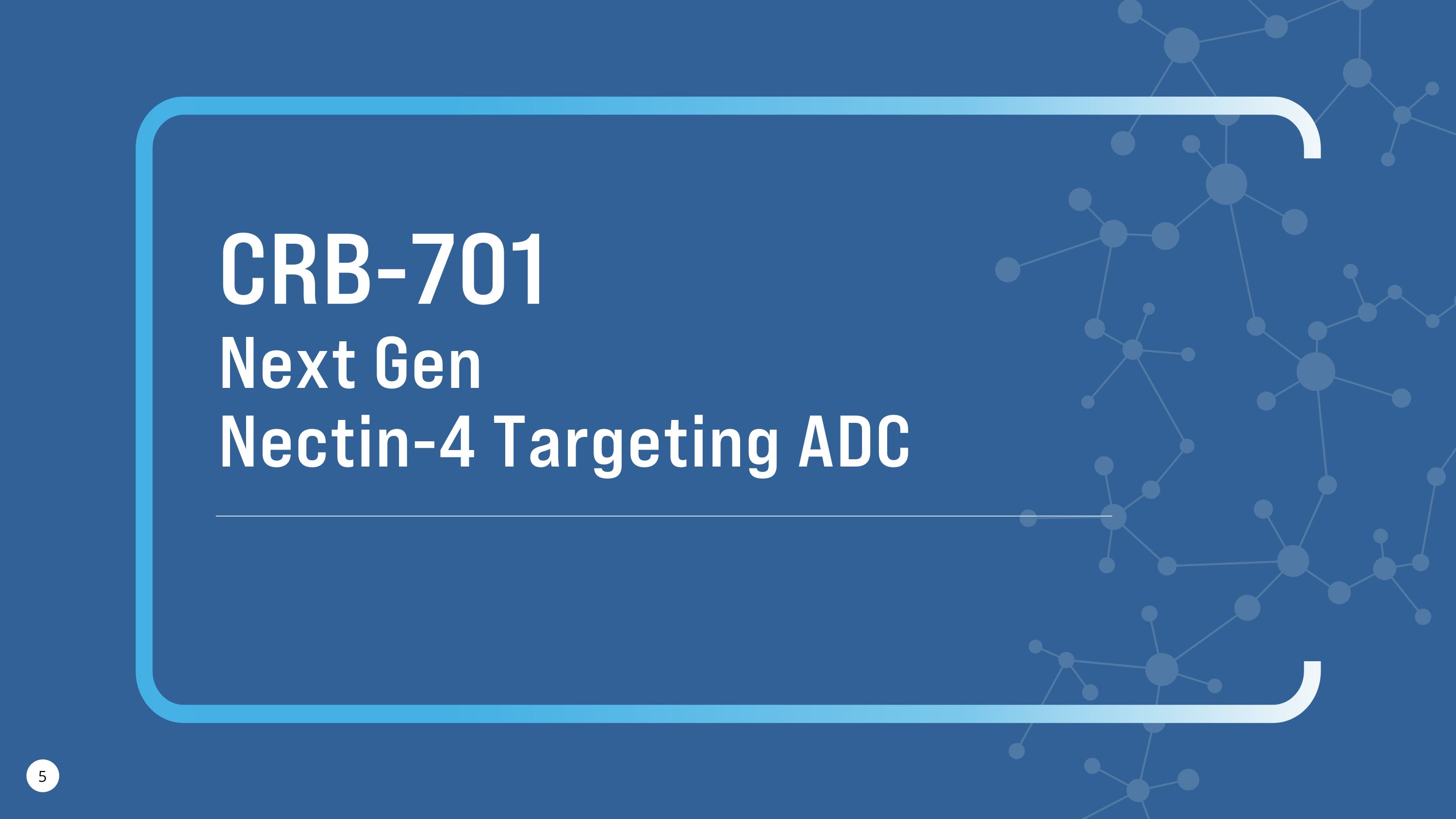
CRB-701 Next Gen Nectin-4 Targeting ADC
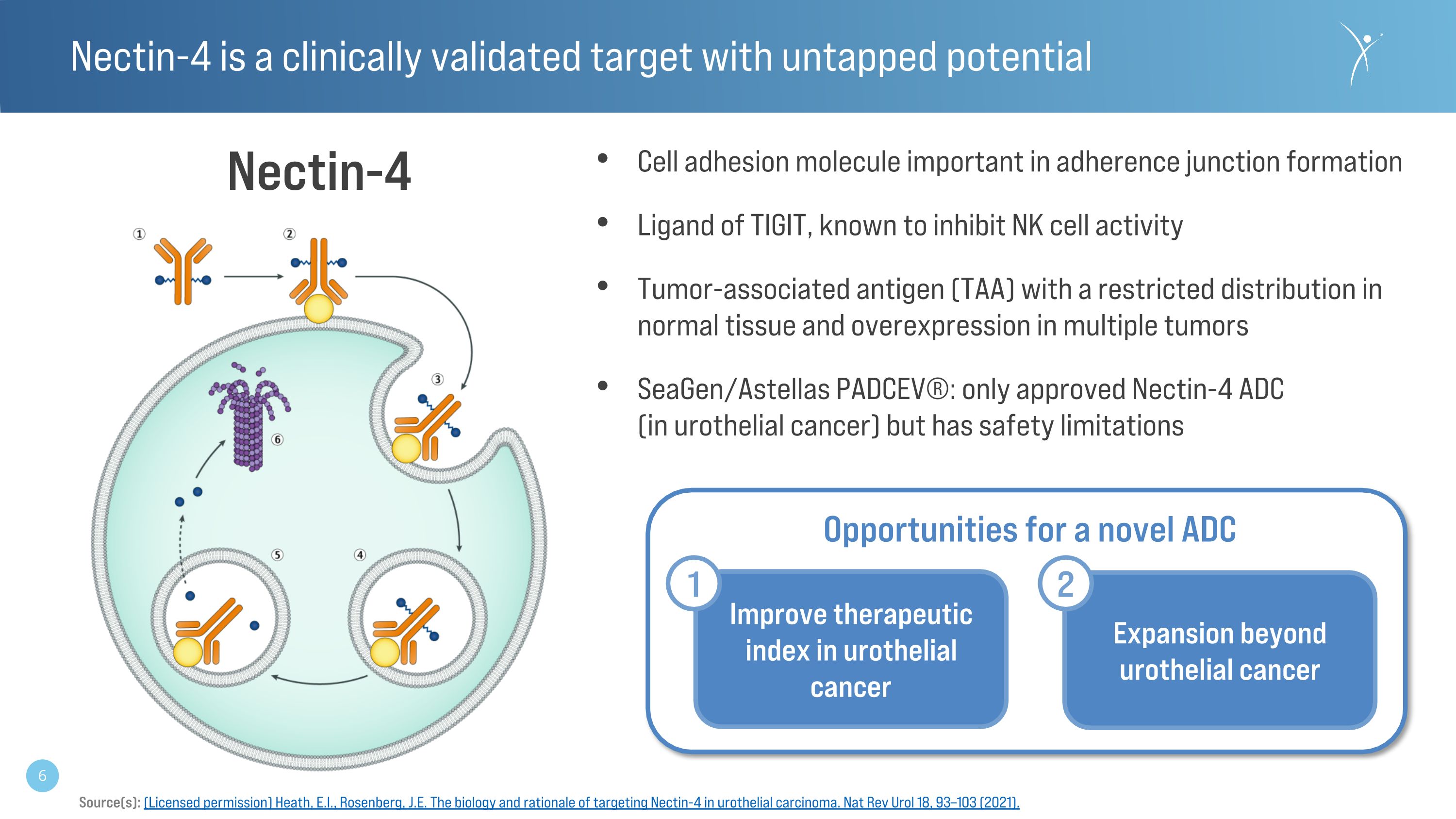
Nectin-4 is a clinically validated target with untapped potential Cell adhesion molecule important in adherence junction formation Ligand of TIGIT, known to inhibit NK cell activity Tumor-associated antigen (TAA) with a restricted distribution in normal tissue and overexpression in multiple tumors SeaGen/Astellas PADCEV®: only approved Nectin-4 ADC (in urothelial cancer) but has safety limitations Source(s): (Licensed permission) Heath, E.I., Rosenberg, J.E. The biology and rationale of targeting Nectin-4 in urothelial carcinoma. Nat Rev Urol 18, 93–103 (2021). *Drug-to-antibody ratio Improve therapeutic index in urothelial cancer 1 Expansion beyond urothelial cancer 2 Opportunities for a novel ADC Nectin-4
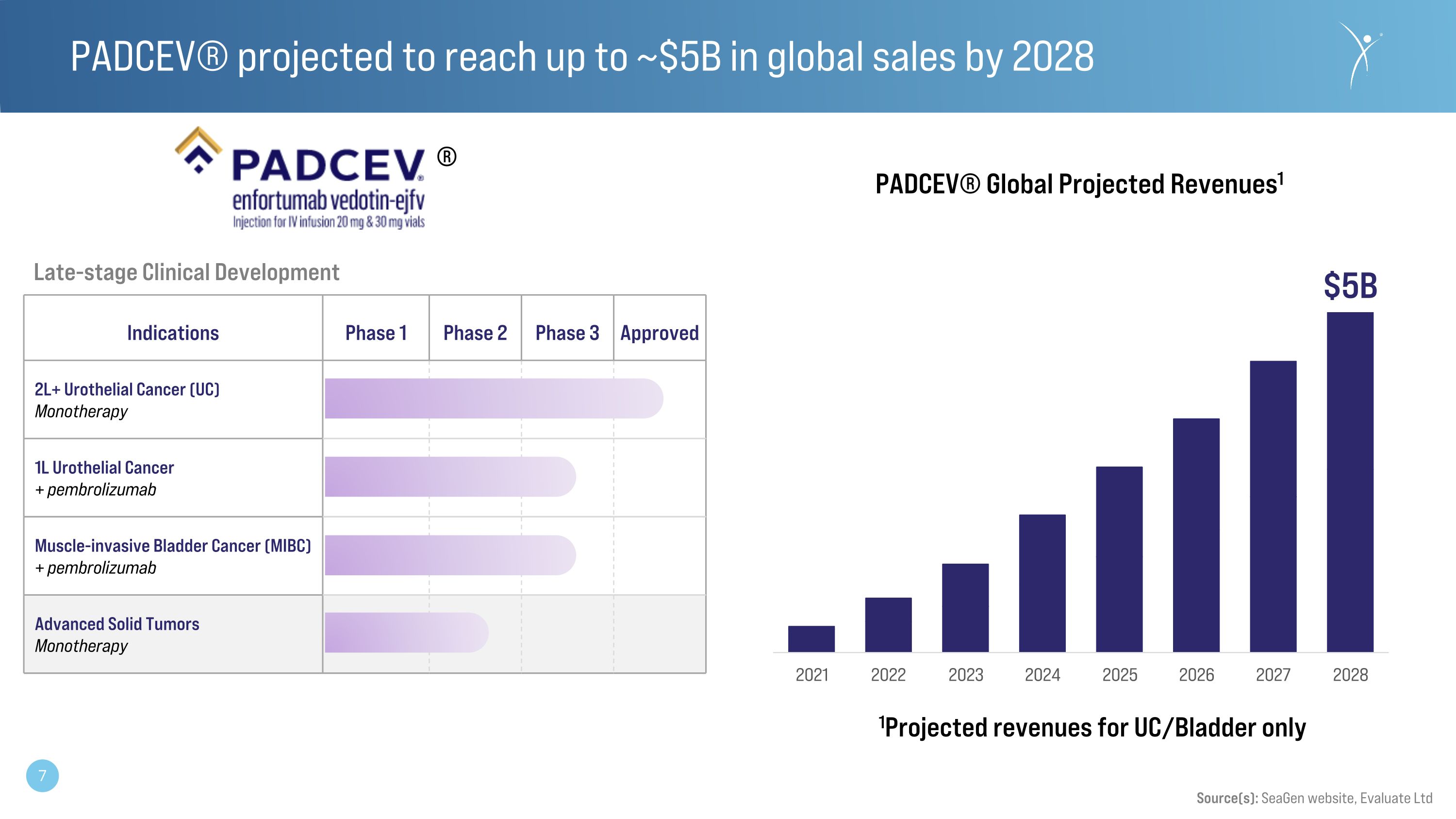
PADCEV® projected to reach up to ~$5B in global sales by 2028 Late-stage Clinical Development Source(s): SeaGen website, Evaluate Ltd $5B 1Projected revenues for UC/Bladder only Indications Phase 1 Phase 2 Phase 3 Approved 2L+ Urothelial Cancer (UC) Monotherapy 1L Urothelial Cancer + pembrolizumab Muscle-invasive Bladder Cancer (MIBC) + pembrolizumab Advanced Solid Tumors Monotherapy ®
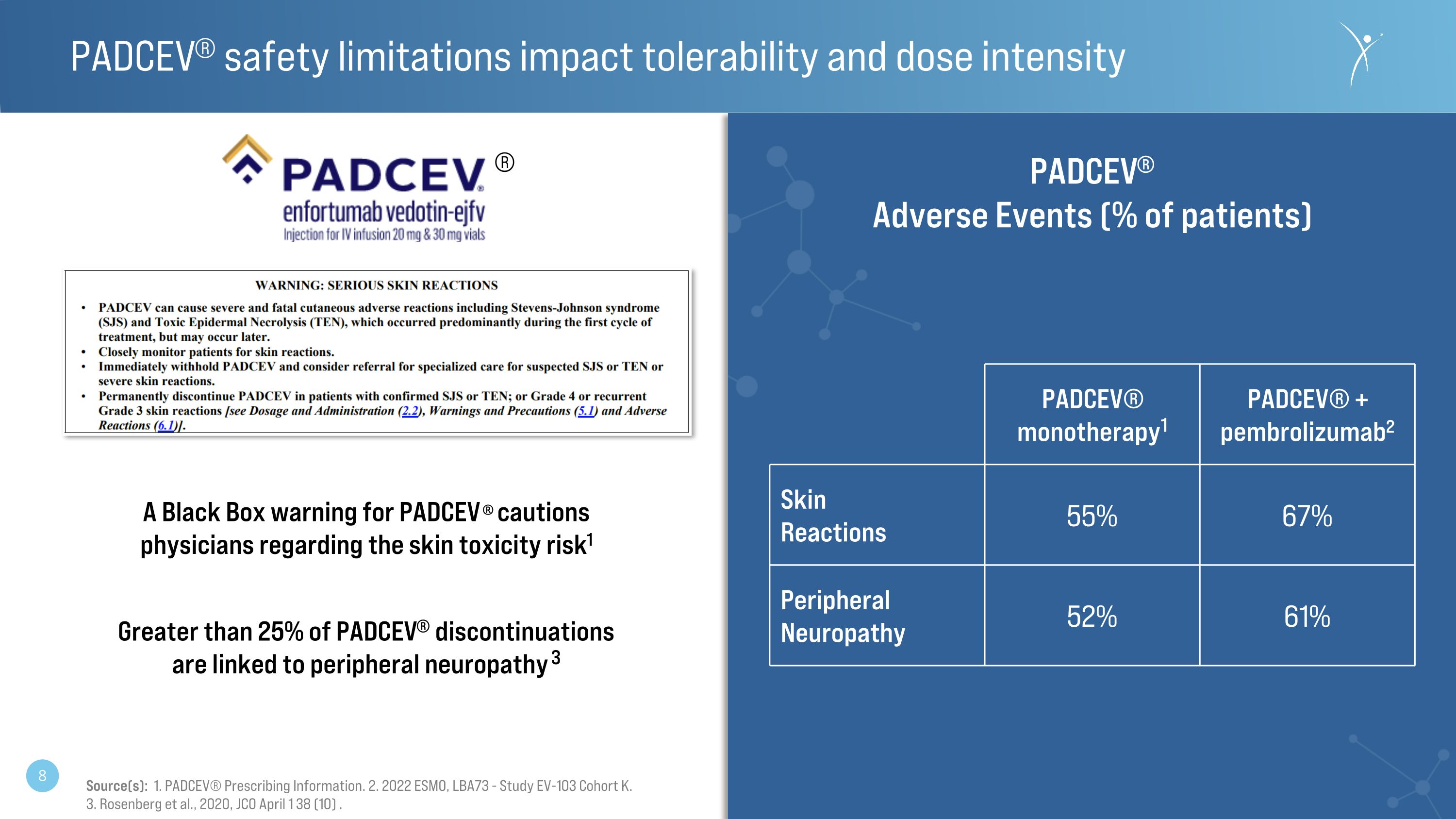
PADCEV® safety limitations impact tolerability and dose intensity A Black Box warning for PADCEV ® cautions physicians regarding the skin toxicity risk1 PADCEV® monotherapy1 PADCEV® + pembrolizumab2 Skin Reactions 55% 67% Peripheral Neuropathy 52% 61% PADCEV® Adverse Events (% of patients) Source(s): 1. PADCEV® Prescribing Information. 2. 2022 ESMO, LBA73 - Study EV-103 Cohort K. 3. Rosenberg et al., 2020, JCO April 1 38 (10) . Greater than 25% of PADCEV® discontinuations are linked to peripheral neuropathy 3 ®
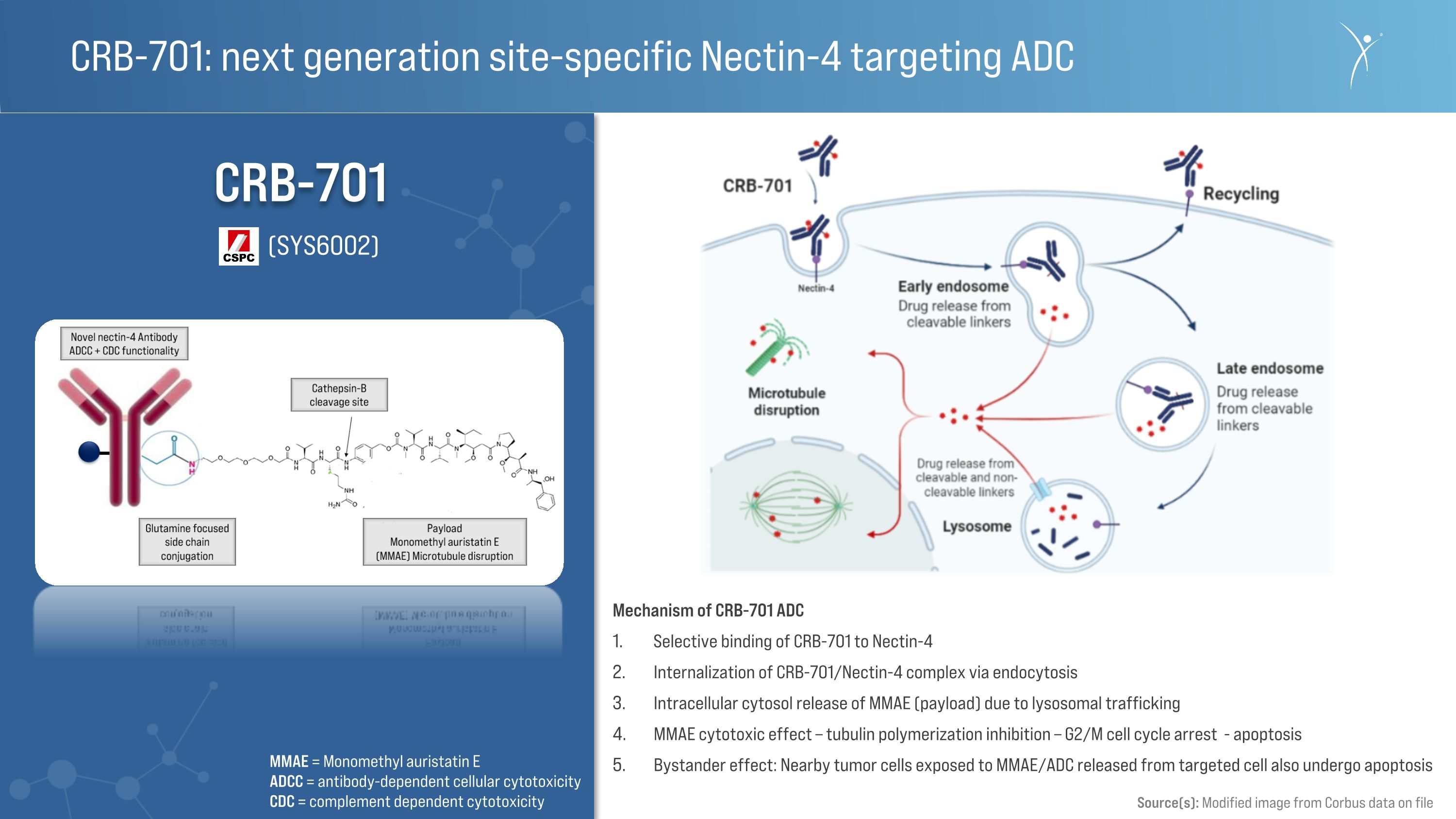
CRB-701 CRB-701: next generation site-specific Nectin-4 targeting ADC CRB-701 Mechanism of CRB-701 ADC Selective binding of CRB-701 to Nectin-4 Internalization of CRB-701/Nectin-4 complex via endocytosis Intracellular cytosol release of MMAE (payload) due to lysosomal trafficking MMAE cytotoxic effect – tubulin polymerization inhibition – G2/M cell cycle arrest - apoptosis Bystander effect: Nearby tumor cells exposed to MMAE/ADC released from targeted cell also undergo apoptosis Source(s): Modified image from Corbus data on file (SYS6002) MMAE = Monomethyl auristatin E ADCC = antibody-dependent cellular cytotoxicity CDC = complement dependent cytotoxicity
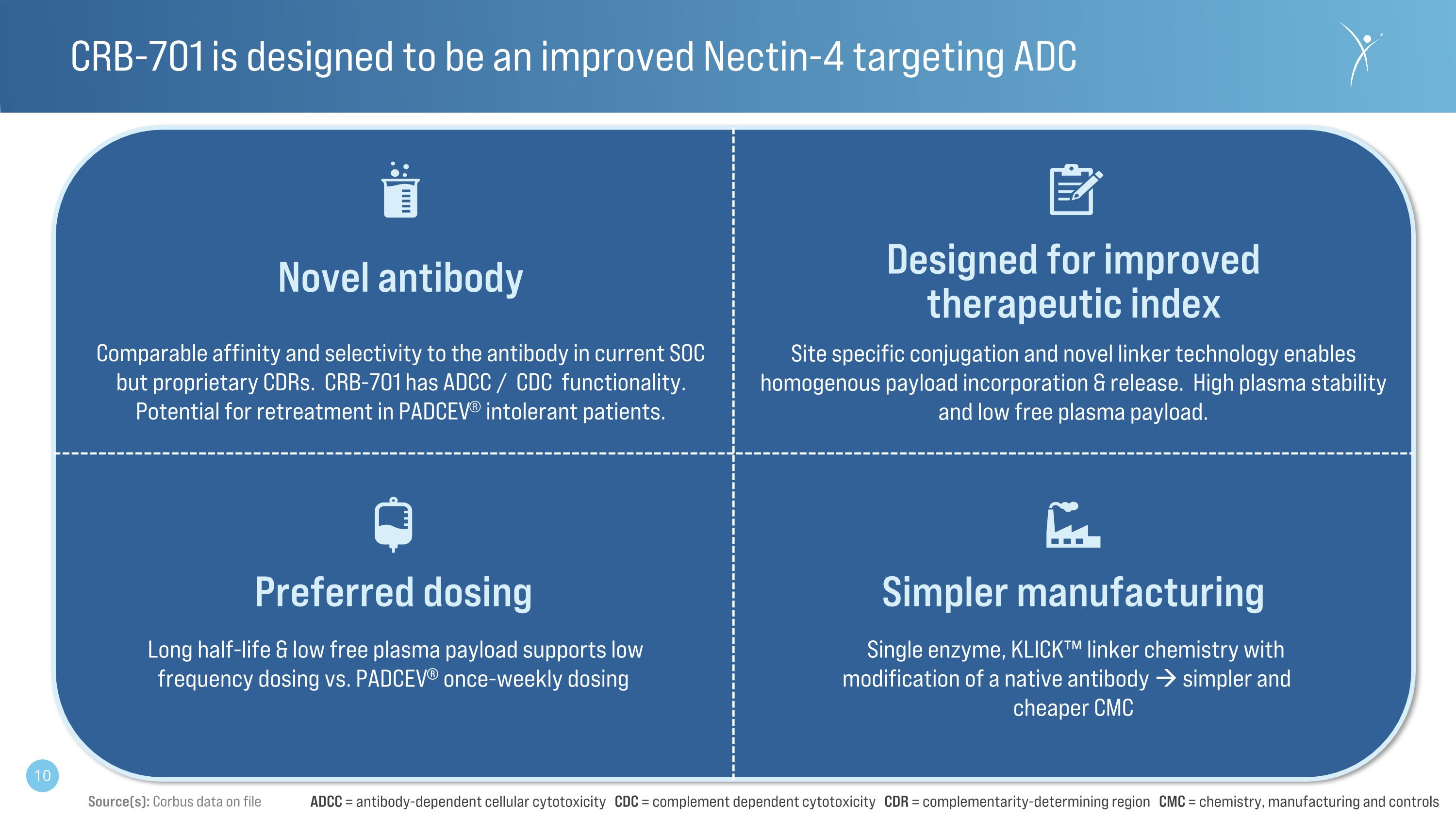
CRB-701 is designed to be an improved Nectin-4 targeting ADC Novel antibody Comparable affinity and selectivity to the antibody in current SOC but proprietary CDRs. CRB-701 has ADCC / CDC functionality. Potential for retreatment in PADCEV® intolerant patients. Designed for improved therapeutic index Site specific conjugation and novel linker technology enables homogenous payload incorporation & release. High plasma stability and low free plasma payload. Simpler manufacturing Single enzyme, KLICK™ linker chemistry with modification of a native antibody simpler and cheaper CMC Preferred dosing Long half-life & low free plasma payload supports low frequency dosing vs. PADCEV® once-weekly dosing Source(s): Corbus data on file ADCC = antibody-dependent cellular cytotoxicity CDC = complement dependent cytotoxicity CDR = complementarity-determining region CMC = chemistry, manufacturing and controls
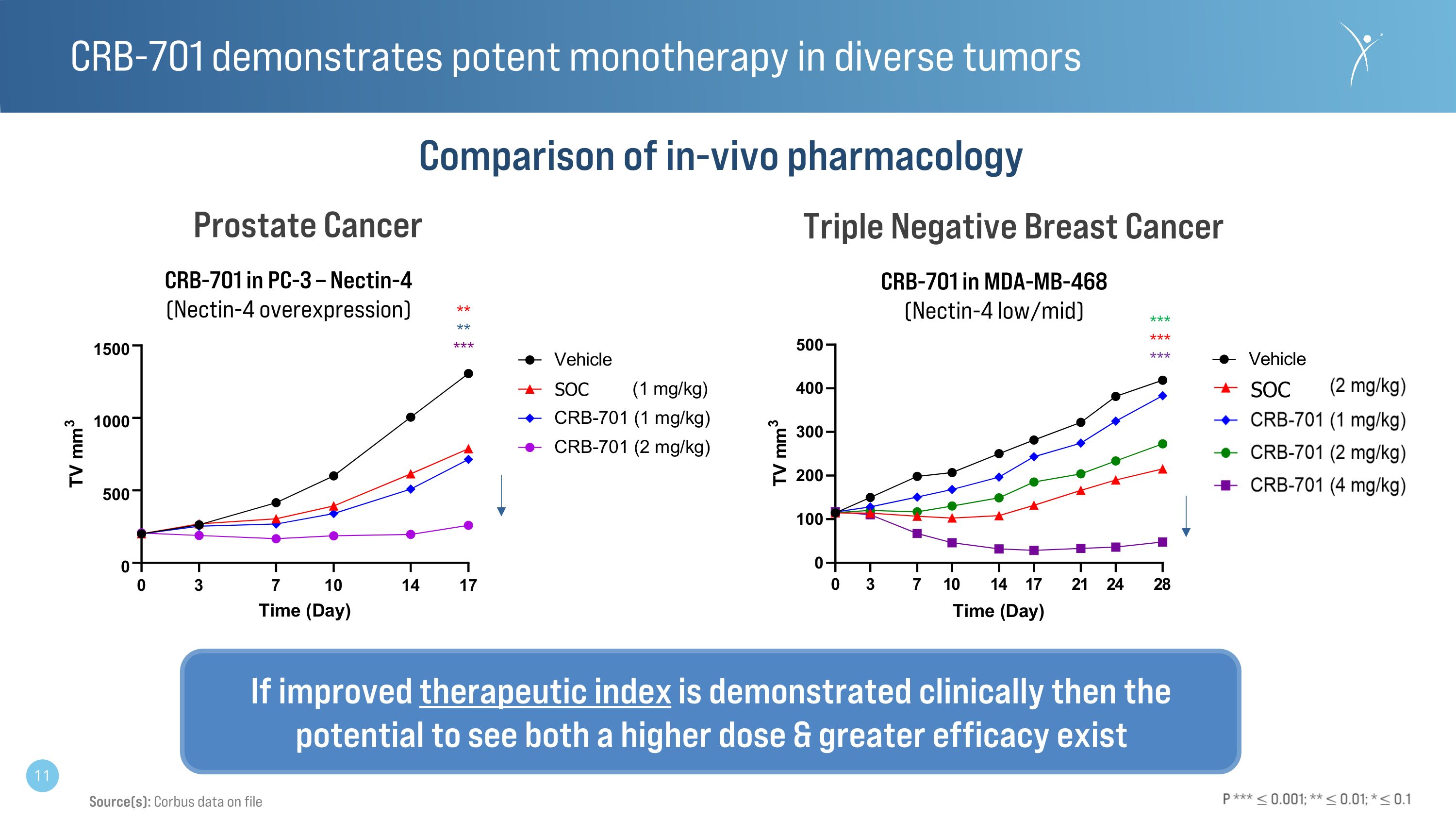
CRB-701 demonstrates potent monotherapy in diverse tumors Comparison of in-vivo pharmacology Prostate Cancer Triple Negative Breast Cancer P *** 0.001; ** 0.01; * 0.1 If improved therapeutic index is demonstrated clinically then the potential to see both a higher dose & greater efficacy exist ** ** *** *** *** *** CRB-701 in PC-3 – Nectin-4 (Nectin-4 overexpression) CRB-701 in MDA-MB-468 (Nectin-4 low/mid) SOC SOC Source(s): Corbus data on file
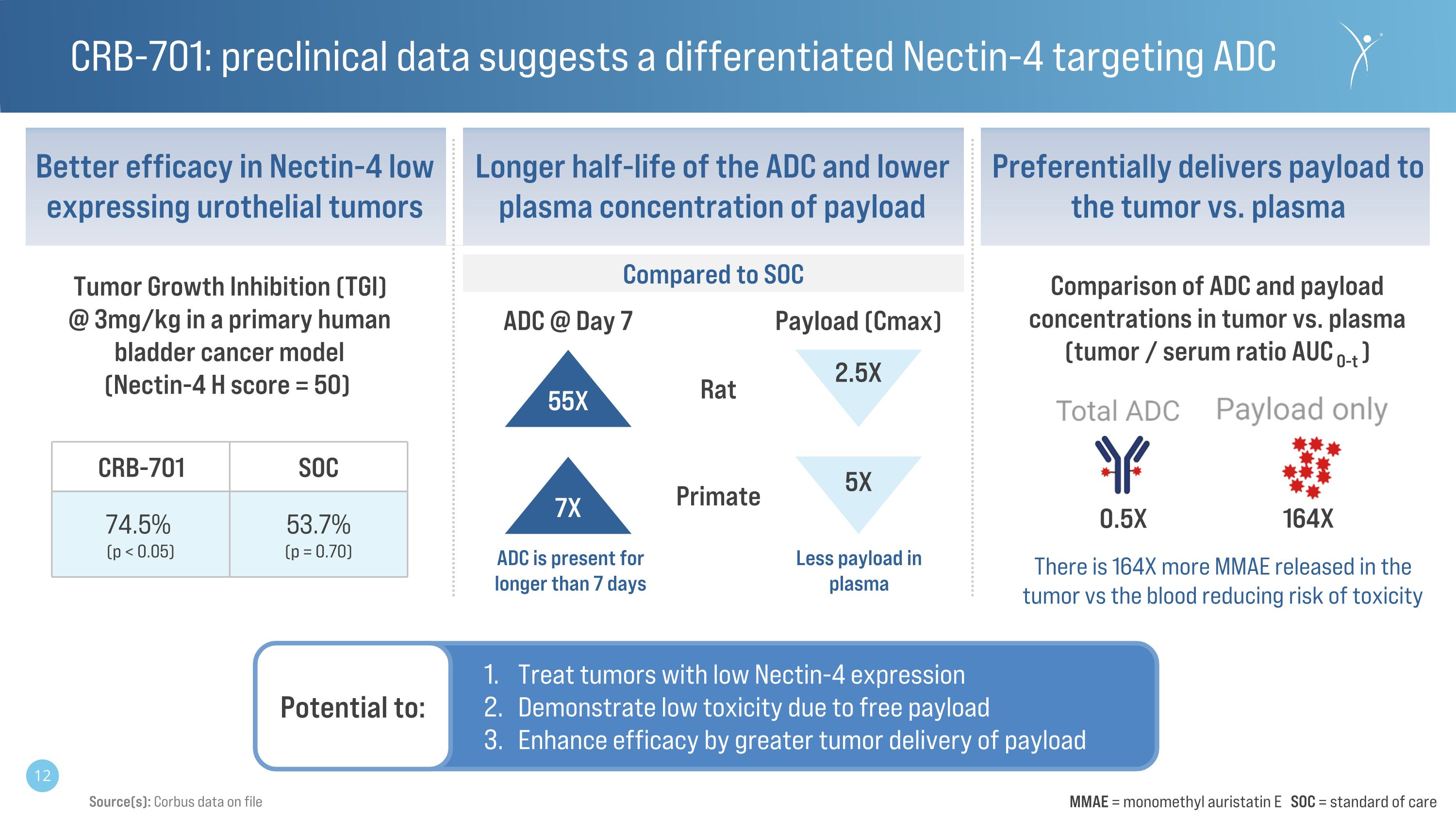
CRB-701: preclinical data suggests a differentiated Nectin-4 targeting ADC Longer half-life of the ADC and lower plasma concentration of payload Preferentially delivers payload to the tumor vs. plasma Better efficacy in Nectin-4 low expressing urothelial tumors Tumor Growth Inhibition (TGI) @ 3mg/kg in a primary human bladder cancer model (Nectin-4 H score = 50) CRB-701 SOC 74.5% (p < 0.05) 53.7% (p = 0.70) Rat Primate Treat tumors with low Nectin-4 expression Demonstrate low toxicity due to free payload Enhance efficacy by greater tumor delivery of payload Comparison of ADC and payload concentrations in tumor vs. plasma (tumor / serum ratio AUC 0-t ) Source(s): Corbus data on file MMAE = monomethyl auristatin E SOC = standard of care There is 164X more MMAE released in the tumor vs the blood reducing risk of toxicity 164X 0.5X Potential to: 55X 7X ADC @ Day 7 2.5X 5X Payload (Cmax) Compared to SOC ADC is present for longer than 7 days Less payload in plasma
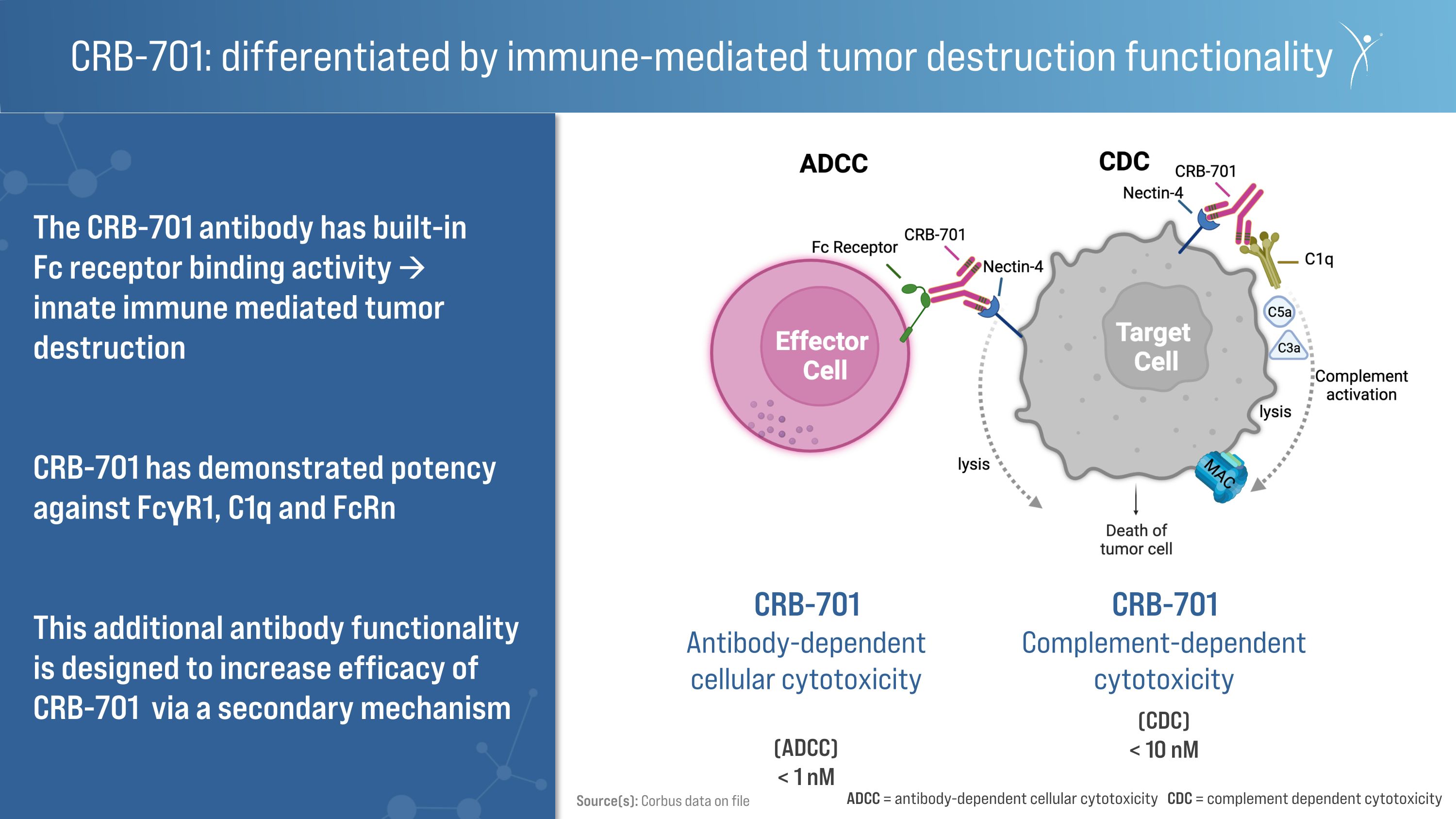
CRB-701: differentiated by immune-mediated tumor destruction functionality The CRB-701 antibody has built-in Fc receptor binding activity innate immune mediated tumor destruction CRB-701 has demonstrated potency against FcγR1, C1q and FcRn This additional antibody functionality is designed to increase efficacy of CRB-701 via a secondary mechanism CRB-701 Antibody-dependent cellular cytotoxicity (ADCC) < 1 nM CRB-701 Complement-dependent cytotoxicity (CDC) < 10 nM Source(s): Corbus data on file ADCC = antibody-dependent cellular cytotoxicity CDC = complement dependent cytotoxicity
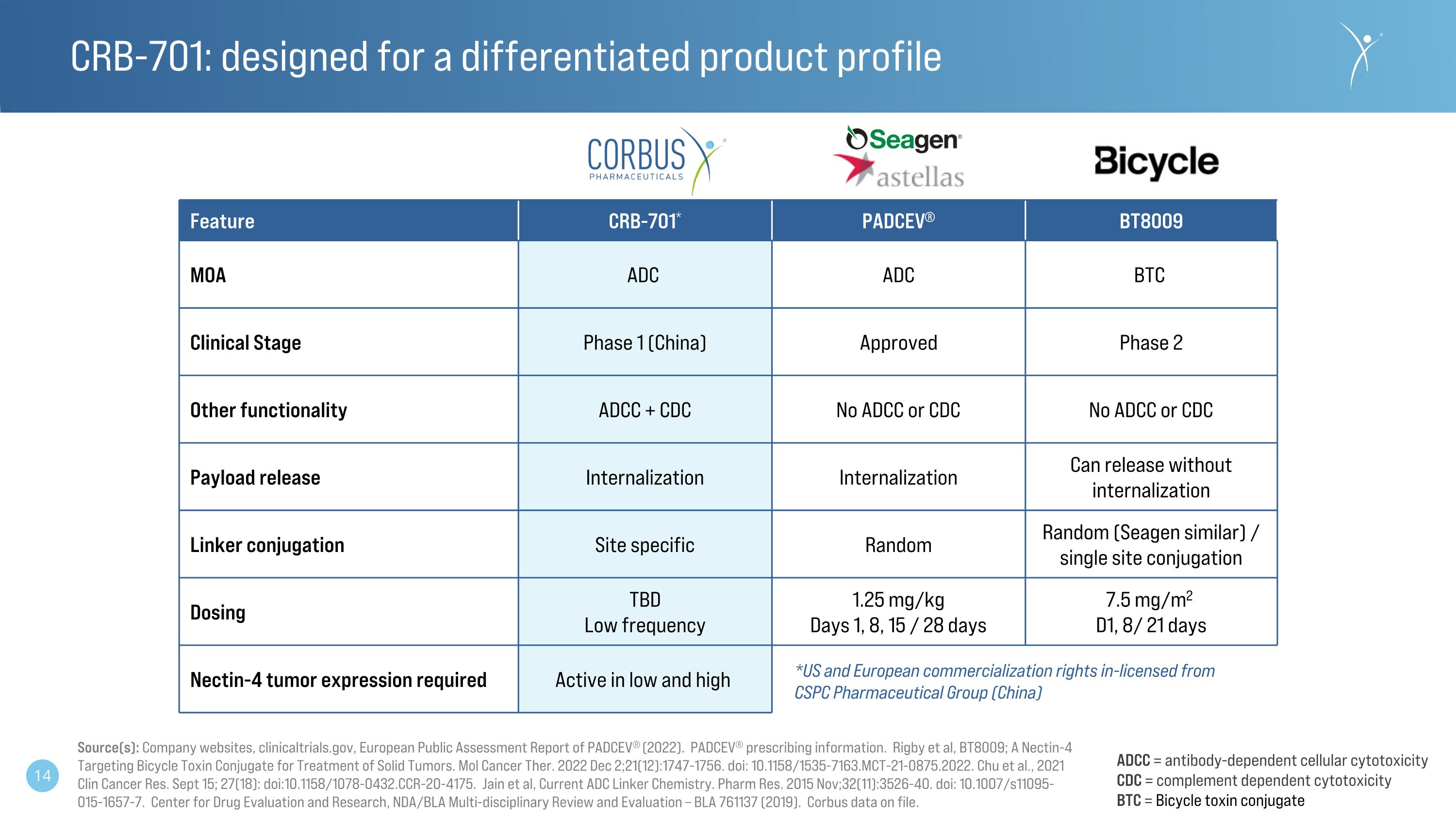
CRB-701: designed for a differentiated product profile Feature CRB-701* PADCEV® BT8009 MOA ADC ADC BTC Clinical Stage Phase 1 (China) Approved Phase 2 Other functionality ADCC + CDC No ADCC or CDC No ADCC or CDC Payload release Internalization Internalization Can release without internalization Linker conjugation Site specific Random Random (Seagen similar) / single site conjugation Dosing TBD Low frequency 1.25 mg/kg Days 1, 8, 15 / 28 days 7.5 mg/m2 D1, 8/ 21 days Nectin-4 tumor expression required Active in low and high Source(s): Company websites, clinicaltrials.gov, European Public Assessment Report of PADCEV® (2022). PADCEV® prescribing information. Rigby et al, BT8009; A Nectin-4 Targeting Bicycle Toxin Conjugate for Treatment of Solid Tumors. Mol Cancer Ther. 2022 Dec 2;21(12):1747-1756. doi: 10.1158/1535-7163.MCT-21-0875.2022. Chu et al., 2021 Clin Cancer Res. Sept 15; 27(18): doi:10.1158/1078-0432.CCR-20-4175. Jain et al, Current ADC Linker Chemistry. Pharm Res. 2015 Nov;32(11):3526-40. doi: 10.1007/s11095-015-1657-7. Center for Drug Evaluation and Research, NDA/BLA Multi-disciplinary Review and Evaluation – BLA 761137 (2019). Corbus data on file. *US and European commercialization rights in-licensed from CSPC Pharmaceutical Group (China) ADCC = antibody-dependent cellular cytotoxicity CDC = complement dependent cytotoxicity BTC = Bicycle toxin conjugate

Urothelial cancer provides the first clinical validation of using a Nectin-4 targeting ADC PADCEV® in urothelial cancer 97% of patients were Nectin-4 positive2 290 avg H-score (range 14 - 300) 2 63% of samples had H-scores ≥ 100 in an independent study 524 patients2 PADCEV® monotherapy1 ORR 44% Complete Response 12% Mean DOR 7.6 months Nectin-4 expression spans beyond urothelial cancer3 UC <---- Other highly expressing tumors ----> Source(s): 1. PADCEV® Prescribing Information. 2. Chu et al., 2021 Clin Cancer Res. Sept 15; 27(18): doi:10.1158/1078-0432.CCR-20-4175. 3. Corbus proprietary analysis: Log2 nectin-4 expression in 10,000 individual tumors (primary data from TCGA) Elevated Nectin-4 expression: urothelial, breast, ovarian, cervical, colorectal, rectal, esophageal, gastric, lung, thyroid, prostate, cholangiocarcinoma, pancreatic cancer, testicular cancer
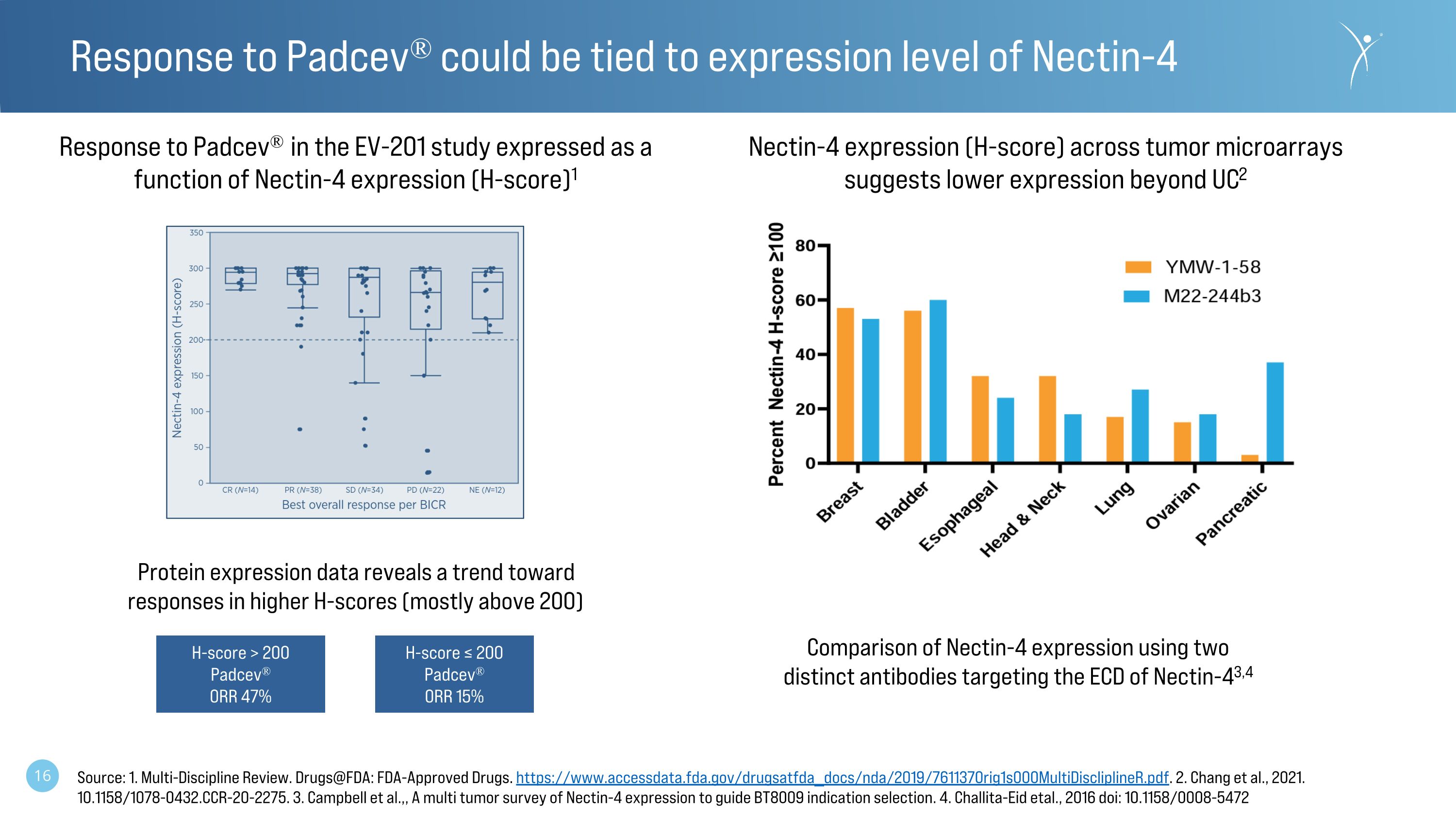
Response to Padcev® could be tied to expression level of Nectin-4 Response to Padcev® in the EV-201 study expressed as a function of Nectin-4 expression (H-score)1 Source: 1. Multi-Discipline Review. Drugs@FDA: FDA-Approved Drugs. https://www.accessdata.fda.gov/drugsatfda_docs/nda/2019/761137Orig1s000MultiDiscliplineR.pdf. 2. Chang et al., 2021. 10.1158/1078-0432.CCR-20-2275. 3. Campbell et al.,, A multi tumor survey of Nectin-4 expression to guide BT8009 indication selection. 4. Challita-Eid etal., 2016 doi: 10.1158/0008-5472 H-score > 200 Padcev® ORR 47% H-score ≤ 200 Padcev® ORR 15% Protein expression data reveals a trend toward responses in higher H-scores (mostly above 200) Nectin-4 expression (H-score) across tumor microarrays suggests lower expression beyond UC2 Comparison of Nectin-4 expression using two distinct antibodies targeting the ECD of Nectin-43,4
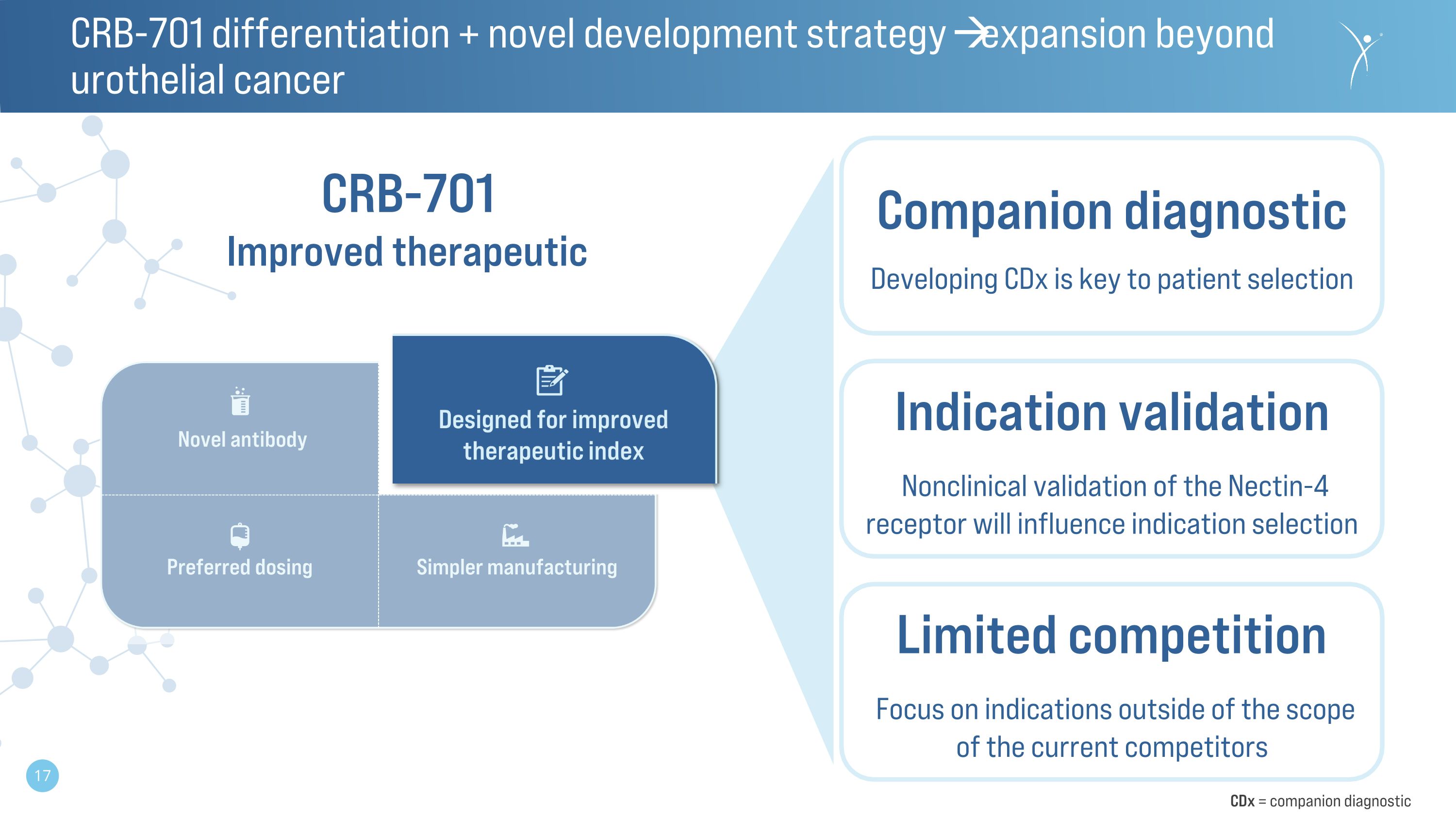
CRB-701 differentiation + novel development strategy expansion beyond urothelial cancer CRB-701 Improved therapeutic Companion diagnostic Developing CDx is key to patient selection Indication validation Nonclinical validation of the Nectin-4 receptor will influence indication selection Limited competition Focus on indications outside of the scope of the current competitors CDx = companion diagnostic
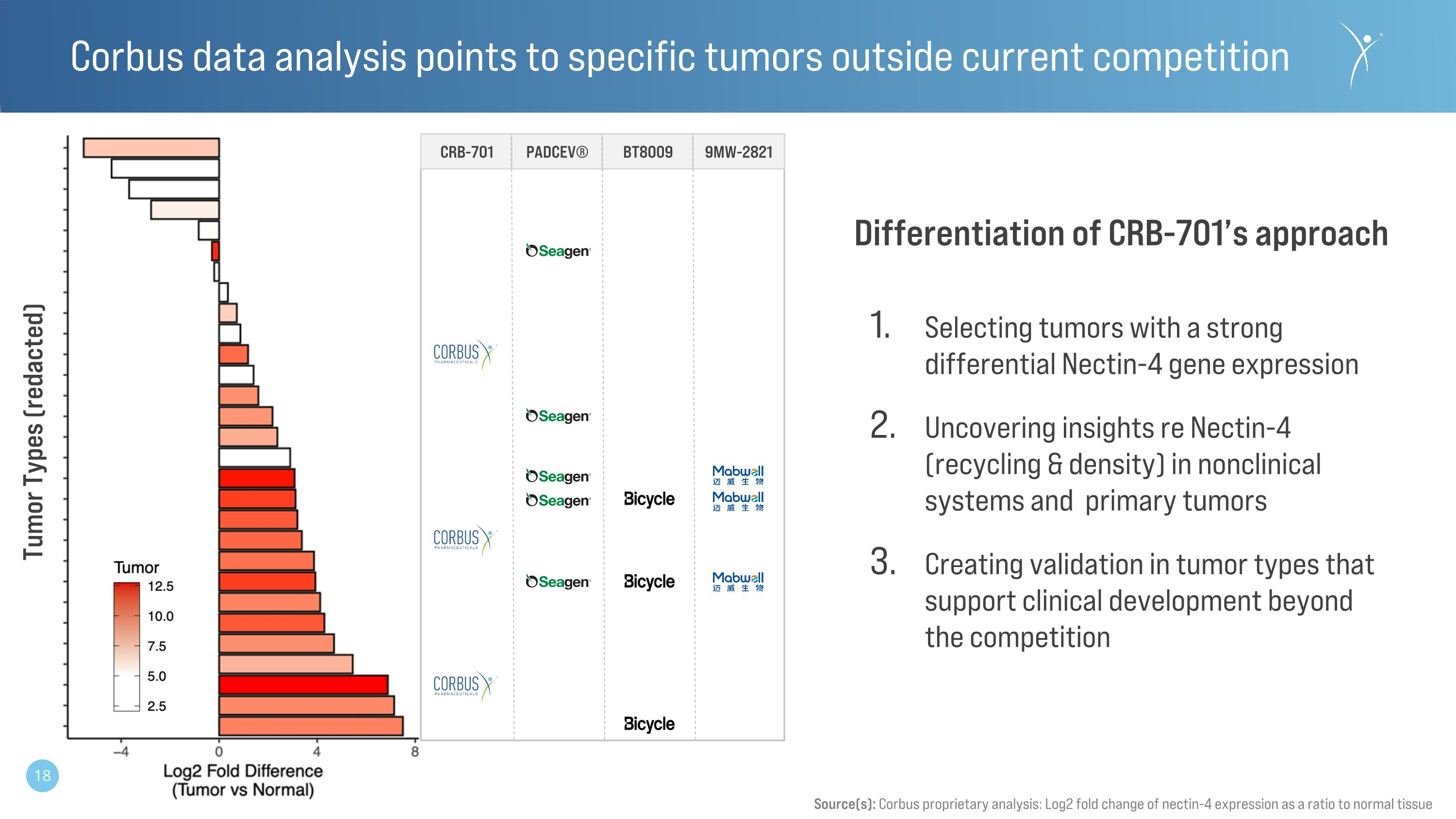
Corbus data analysis points to specific tumors outside current competition Source(s): Corbus proprietary analysis: Log2 fold change of nectin-4 expression as a ratio to normal tissue Differentiation of CRB-701’s approach Selecting tumors with a strong differential Nectin-4 gene expression Uncovering insights re Nectin-4 (recycling & density) in nonclinical systems and primary tumors Creating validation in tumor types that support clinical development beyond the competition Tumor Types (redacted) CRB-701 PADCEV® BT8009 9MW-2821
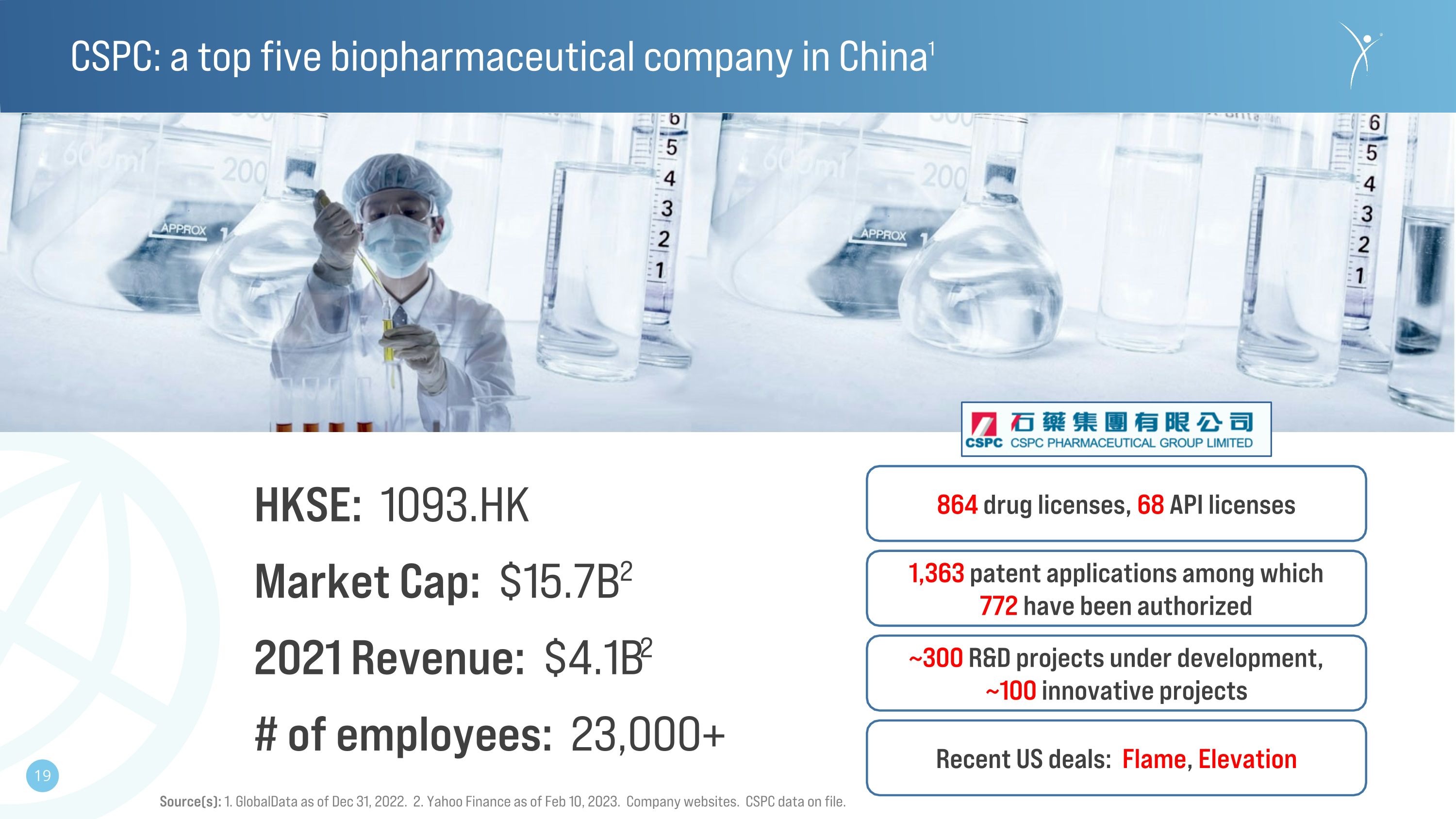
CSPC: a top five biopharmaceutical company in China1 HKSE: 1093.HK Market Cap: $15.7B2 2021 Revenue: $4.1B2 # of employees: 23,000+ 864 drug licenses, 68 API licenses 1,363 patent applications among which 772 have been authorized ~300 R&D projects under development, ~100 innovative projects Recent US deals: Flame, Elevation Source(s): 1. GlobalData as of Dec 31, 2022. 2. Yahoo Finance as of Feb 10, 2023. Company websites. CSPC data on file.

CRB-701 collaboration will leverage CSPC capabilities Translational work on MOA in solid tumors Companion diagnostic validation Clinical bridging study in US using China RP2D (2024) Phase 1b/2 in Nectin-4 enriched solid tumors Dose escalation (underway in China) Urothelial cancer clinical development Companion diagnostic development Clinical drug supply Joint Steering Committee (JSC)
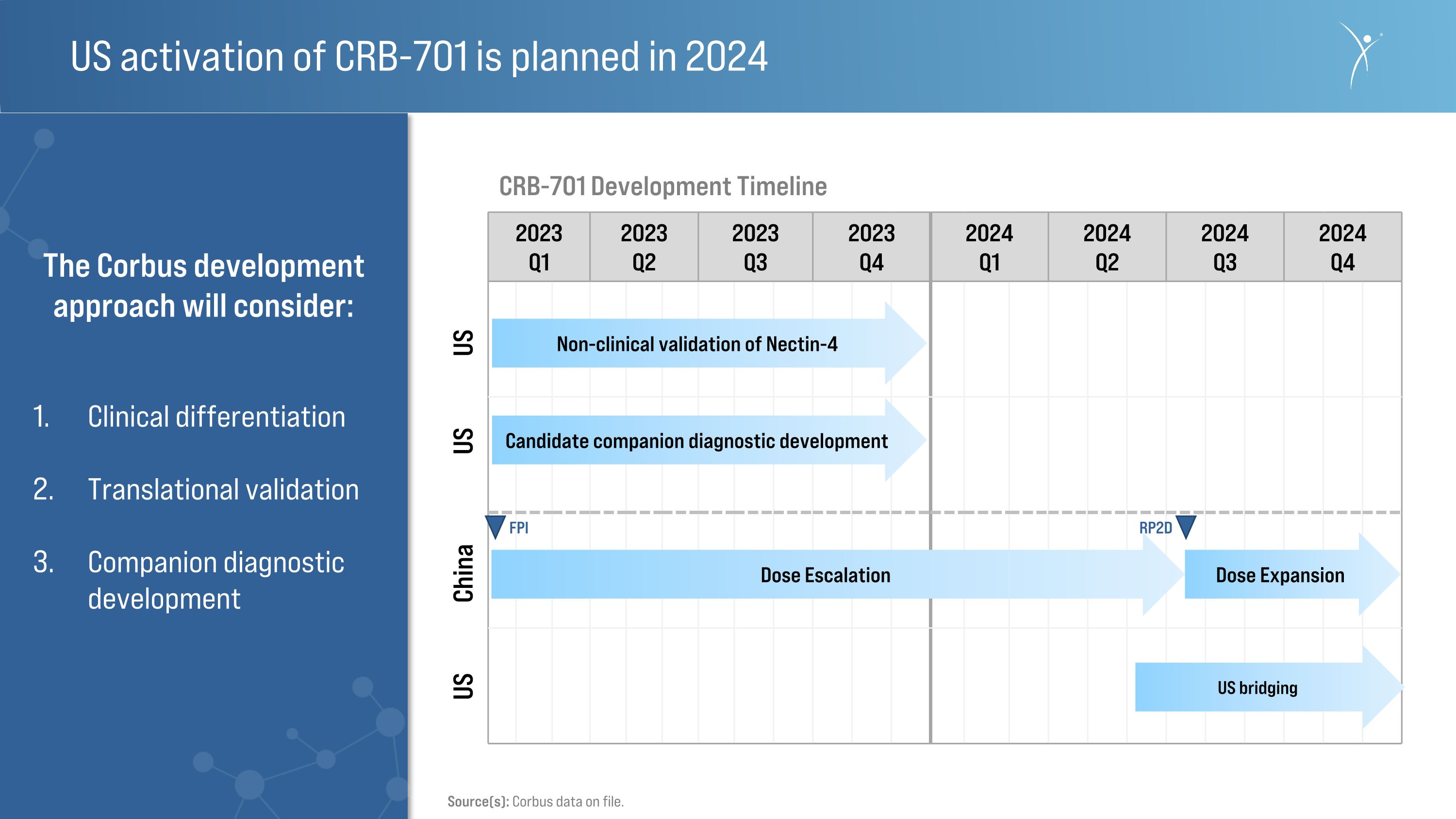
US activation of CRB-701 is planned in 2024 2023 Q1 2023 Q2 2023 Q3 2023 Q4 2024 Q1 2024 Q2 2024 Q3 2024 Q4 The Corbus development approach will consider: Clinical differentiation Translational validation Companion diagnostic development CRB-701 Development Timeline Non-clinical validation of Nectin-4 China US Candidate companion diagnostic development Dose Escalation FPI Dose Expansion US bridging RP2D US US Source(s): Corbus data on file.
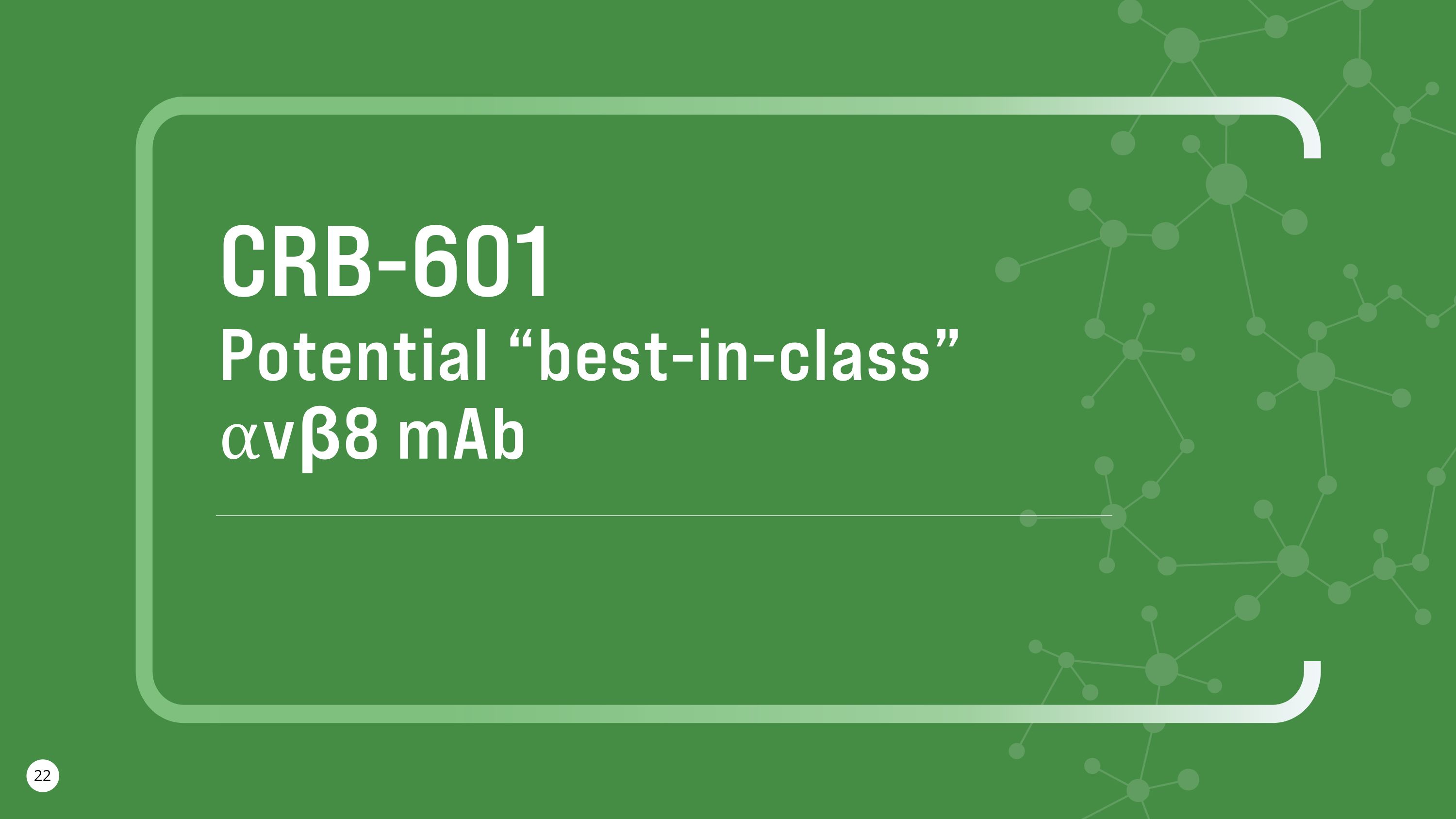
CRB-601 Potential “best-in-class” ⍺vβ8 mAb
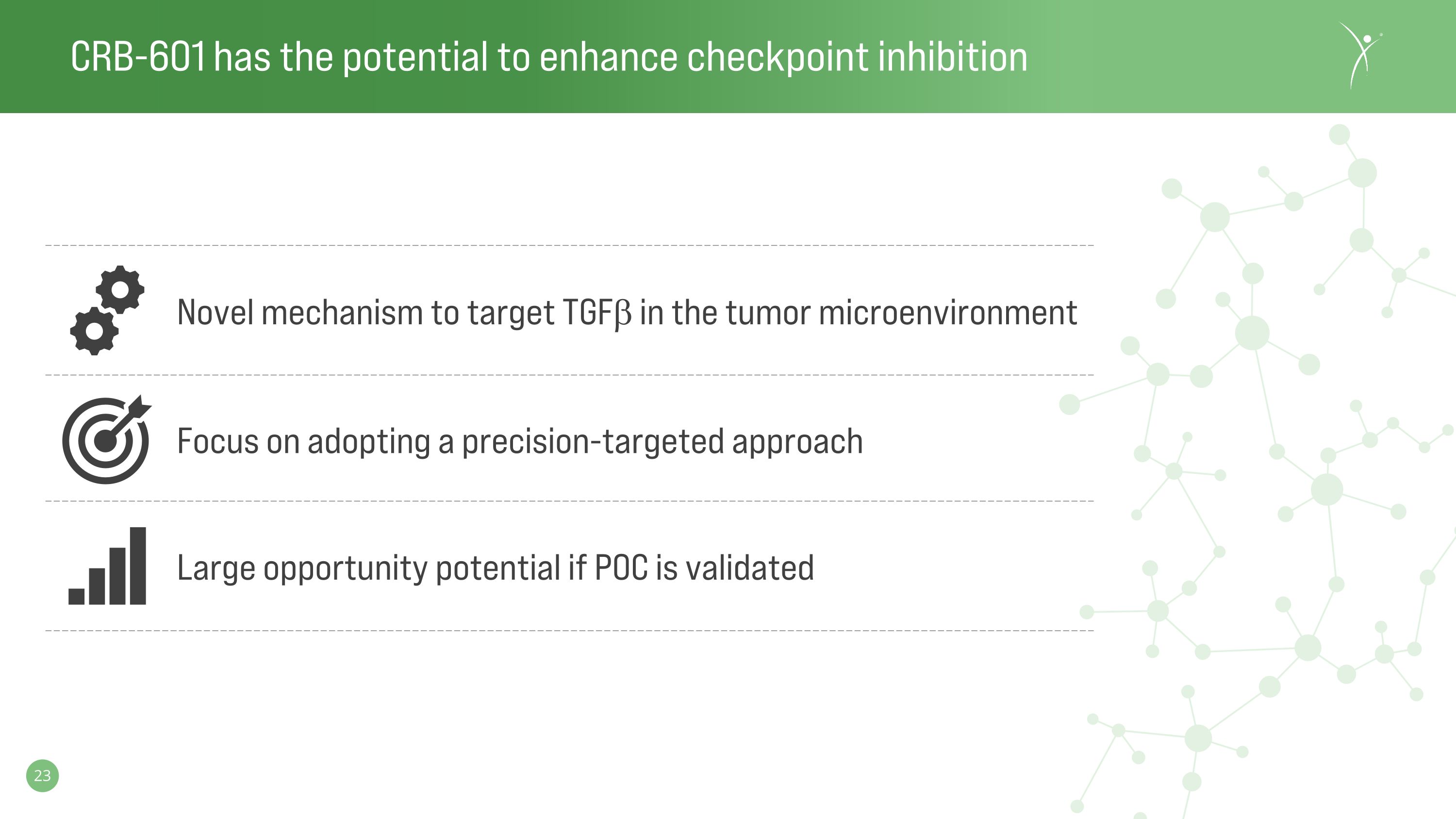
CRB-601 has the potential to enhance checkpoint inhibition Focus on adopting a precision-targeted approach Novel mechanism to target TGFb in the tumor microenvironment Large opportunity potential if POC is validated
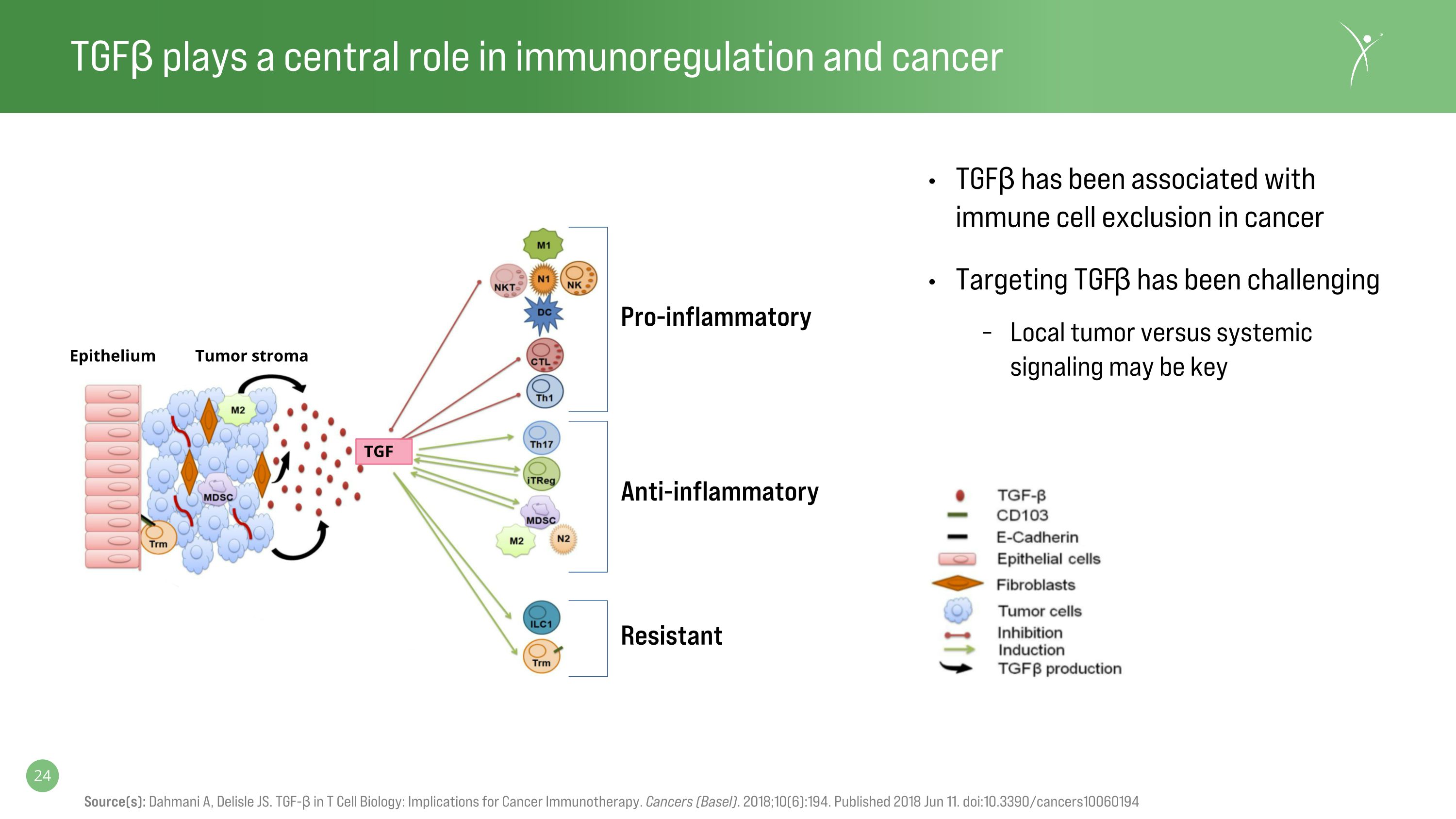
TGFβ TGFβ plays a central role in immunoregulation and cancer Source(s): Dahmani A, Delisle JS. TGF-β in T Cell Biology: Implications for Cancer Immunotherapy. Cancers (Basel). 2018;10(6):194. Published 2018 Jun 11. doi:10.3390/cancers10060194 TGFβ has been associated with immune cell exclusion in cancer Targeting TGFβ has been challenging Local tumor versus systemic signaling may be key Pro-inflammatory Anti-inflammatory Resistant Epithelium Tumor stroma
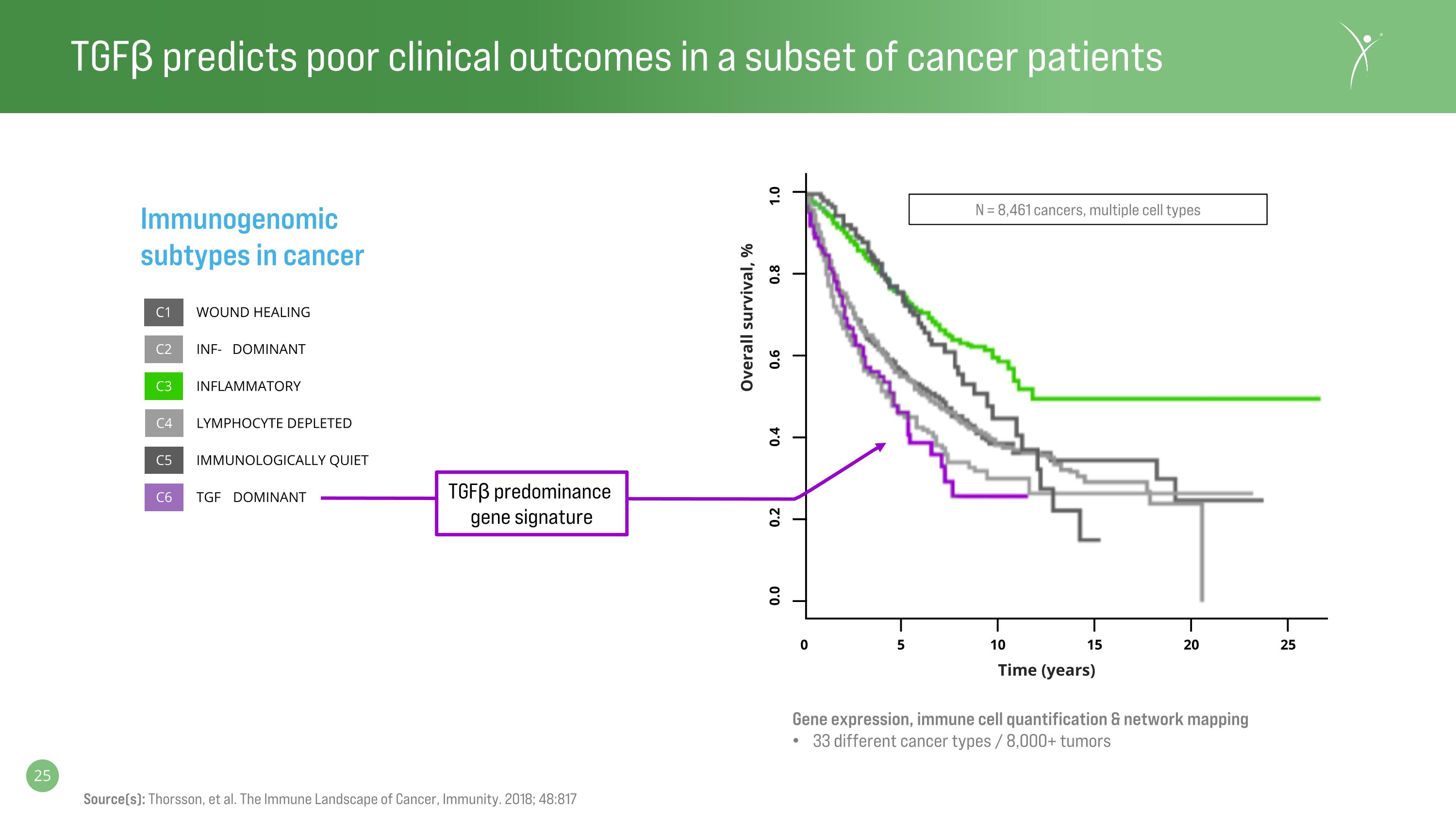
TGFβ predicts poor clinical outcomes in a subset of cancer patients 0 25 20 15 10 5 0.0 0.2 0.4 0.6 0.8 1.0 N = 8,461 cancers, multiple cell types Time (years) Overall survival, % Immunogenomic subtypes in cancer Source(s): Thorsson, et al. The Immune Landscape of Cancer, Immunity. 2018; 48:817 C1 C2 C3 C4 C5 C6 WOUND HEALING INF-γ DOMINANT INFLAMMATORY LYMPHOCYTE DEPLETED IMMUNOLOGICALLY QUIET TGFβ DOMINANT TGFβ predominance gene signature Gene expression, immune cell quantification & network mapping 33 different cancer types / 8,000+ tumors
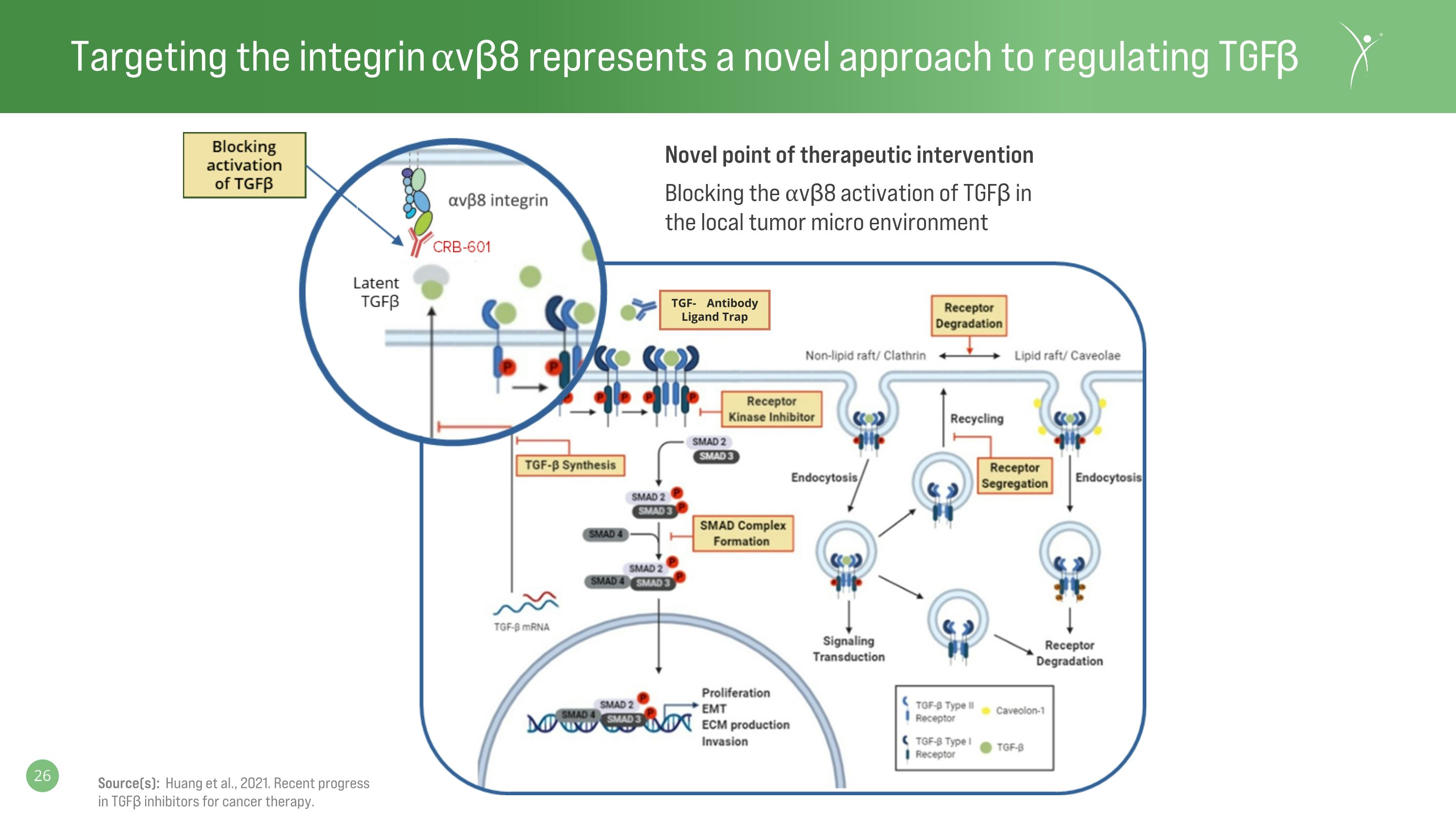
Targeting the integrin ⍺vβ8 represents a novel approach to regulating TGFβ Source(s): Huang et al., 2021. Recent progress in TGFβ inhibitors for cancer therapy. Novel point of therapeutic intervention Blocking the ⍺vβ8 activation of TGFβ in the local tumor micro environment TGF-β Antibody Ligand Trap

Significant opportunity in improving response to PD-1 /L1’s 70 - 80% of patients do not respond to PD-1/L1 therapy1 $70B+ in projected PD-1/L1 sales worldwide by 20282 Opportunity to improve response with biomarker-based, precision combos Source(s): Sun, JY., Zhang, D., Wu, S. et al. Resistance to PD-1/PD-L1 blockade cancer immunotherapy: mechanisms, predictive factors, and future perspectives. Biomark Res 8, 35 (2020). Evaluate, January 2023
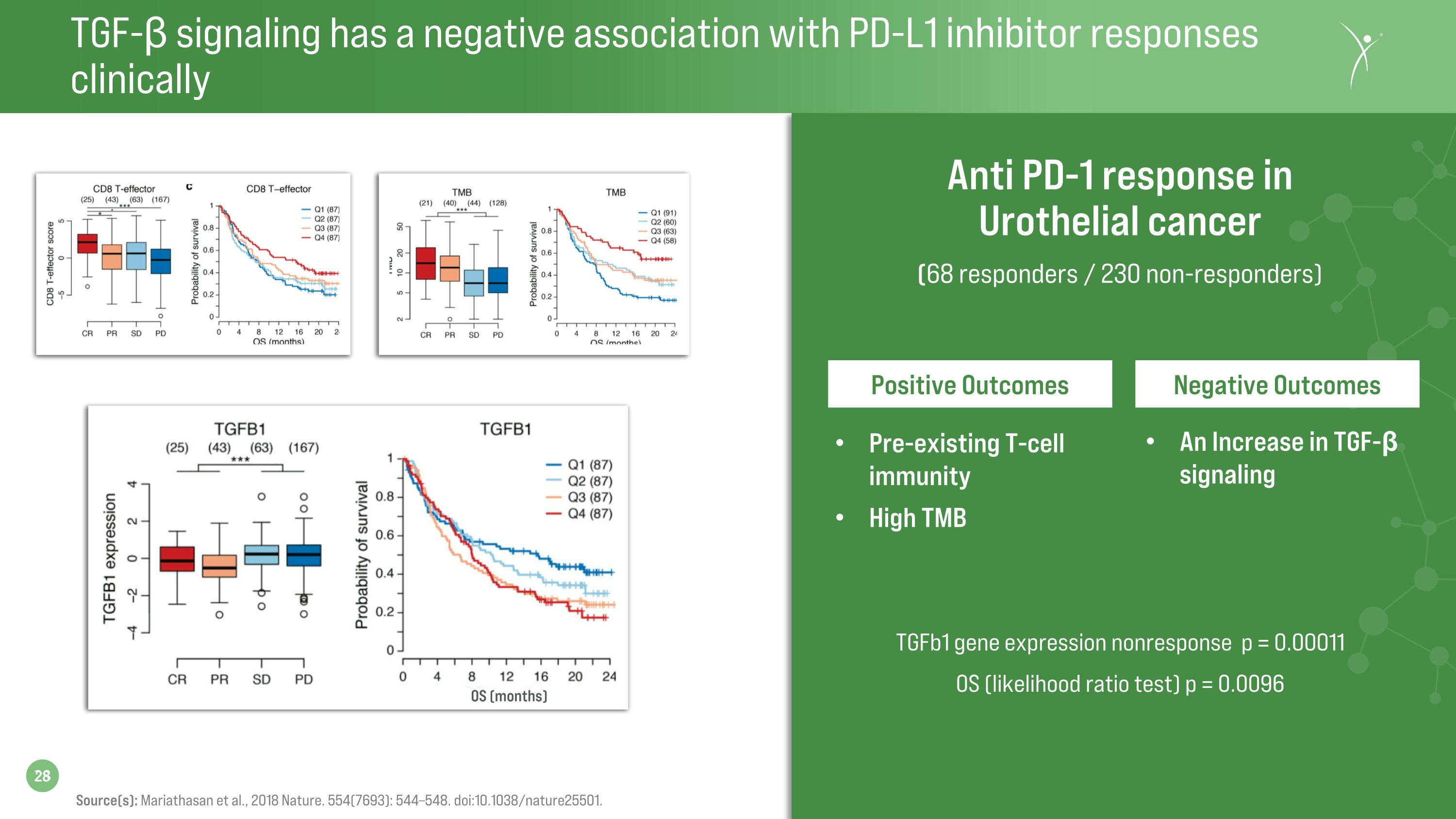
TGF-β signaling has a negative association with PD-L1 inhibitor responses clinically Anti PD-1 response in Urothelial cancer (68 responders / 230 non-responders) TGFb1 gene expression nonresponse p = 0.00011 OS (likelihood ratio test) p = 0.0096 Source(s): Mariathasan et al., 2018 Nature. 554(7693): 544–548. doi:10.1038/nature25501. OS (months) Positive Outcomes Negative Outcomes Pre-existing T-cell immunity High TMB An Increase in TGF-β signaling
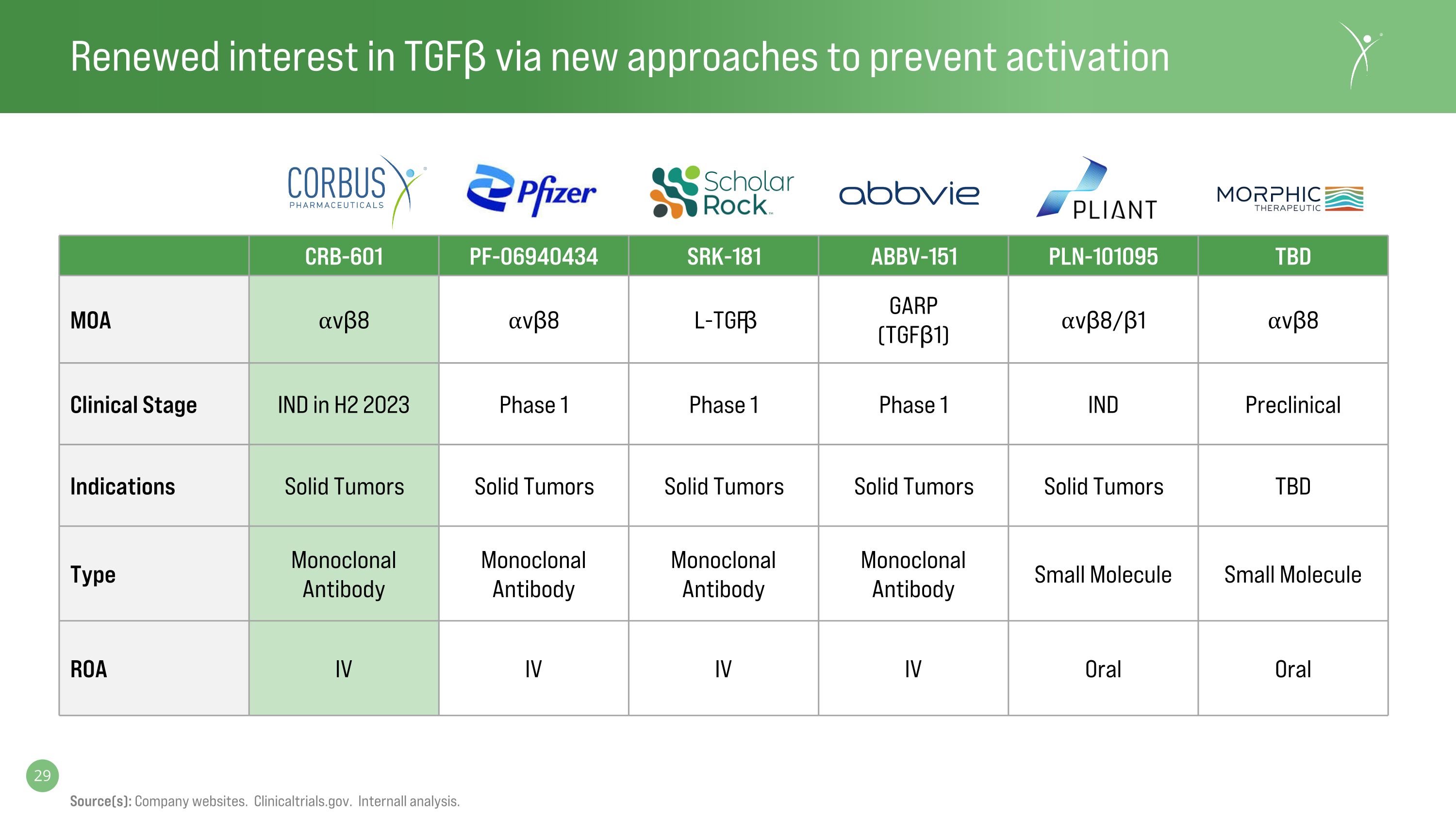
Renewed interest in TGFβ via new approaches to prevent activation Source(s): Company websites. Clinicaltrials.gov. Internall analysis. CRB-601 PF-06940434 SRK-181 ABBV-151 PLN-101095 TBD MOA ⍺vβ8 ⍺vβ8 L-TGFβ GARP (TGFβ1) ⍺vβ8/β1 ⍺vβ8 Clinical Stage IND in H2 2023 Phase 1 Phase 1 Phase 1 IND Preclinical Indications Solid Tumors Solid Tumors Solid Tumors Solid Tumors Solid Tumors TBD Type Monoclonal Antibody Monoclonal Antibody Monoclonal Antibody Monoclonal Antibody Small Molecule Small Molecule ROA IV IV IV IV Oral Oral
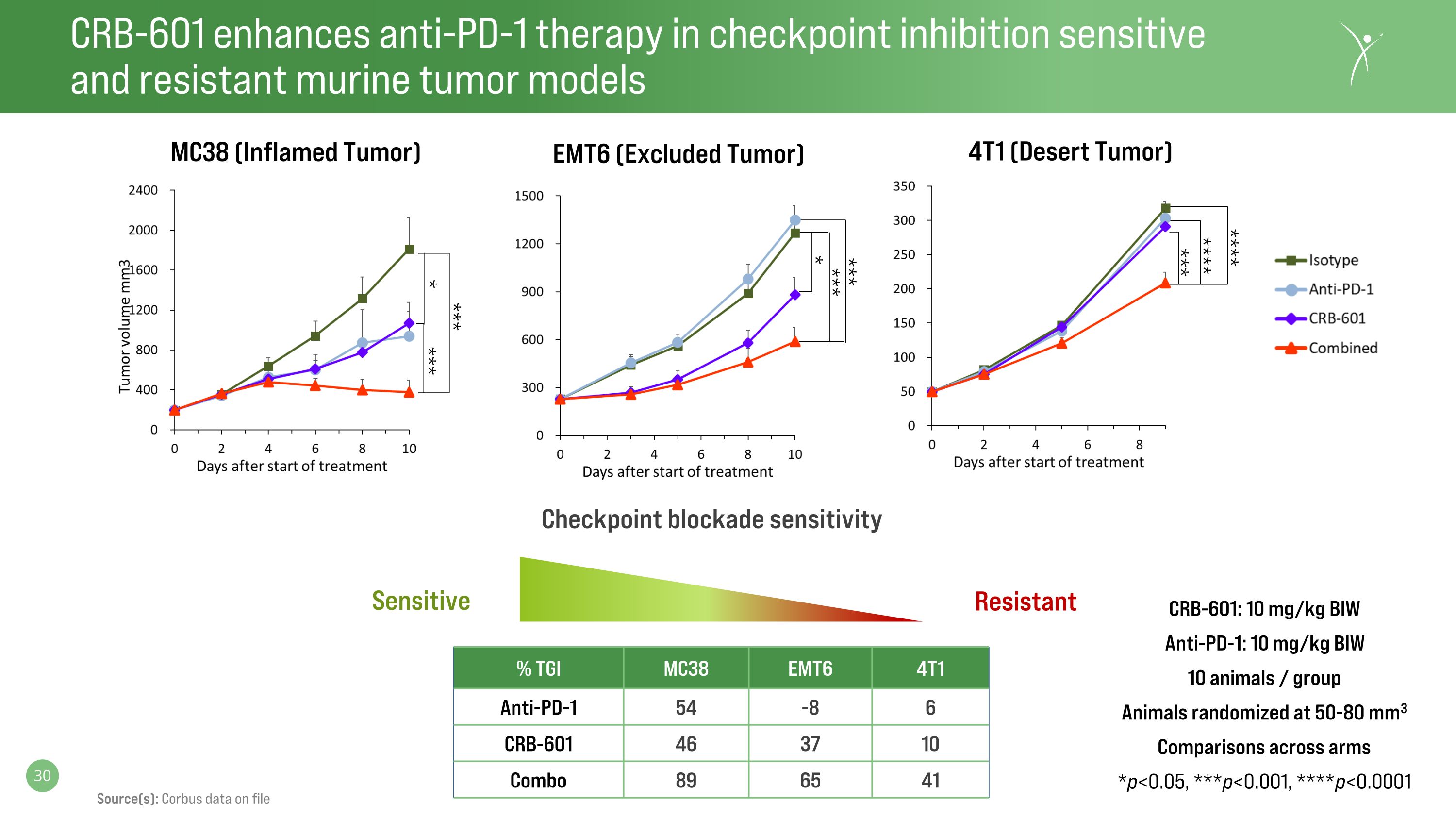
CRB-601 enhances anti-PD-1 therapy in checkpoint inhibition sensitive and resistant murine tumor models CRB-601: 10 mg/kg BIW Anti-PD-1: 10 mg/kg BIW 10 animals / group Animals randomized at 50-80 mm3 Comparisons across arms *p<0.05, ***p<0.001, ****p<0.0001 % TGI MC38 EMT6 4T1 Anti-PD-1 54 -8 6 CRB-601 46 37 10 Combo 89 65 41 Resistant Checkpoint blockade sensitivity Sensitive MC38 (Inflamed Tumor) EMT6 (Excluded Tumor) 4T1 (Desert Tumor) *** **** **** *** * *** *** *** * Source(s): Corbus data on file
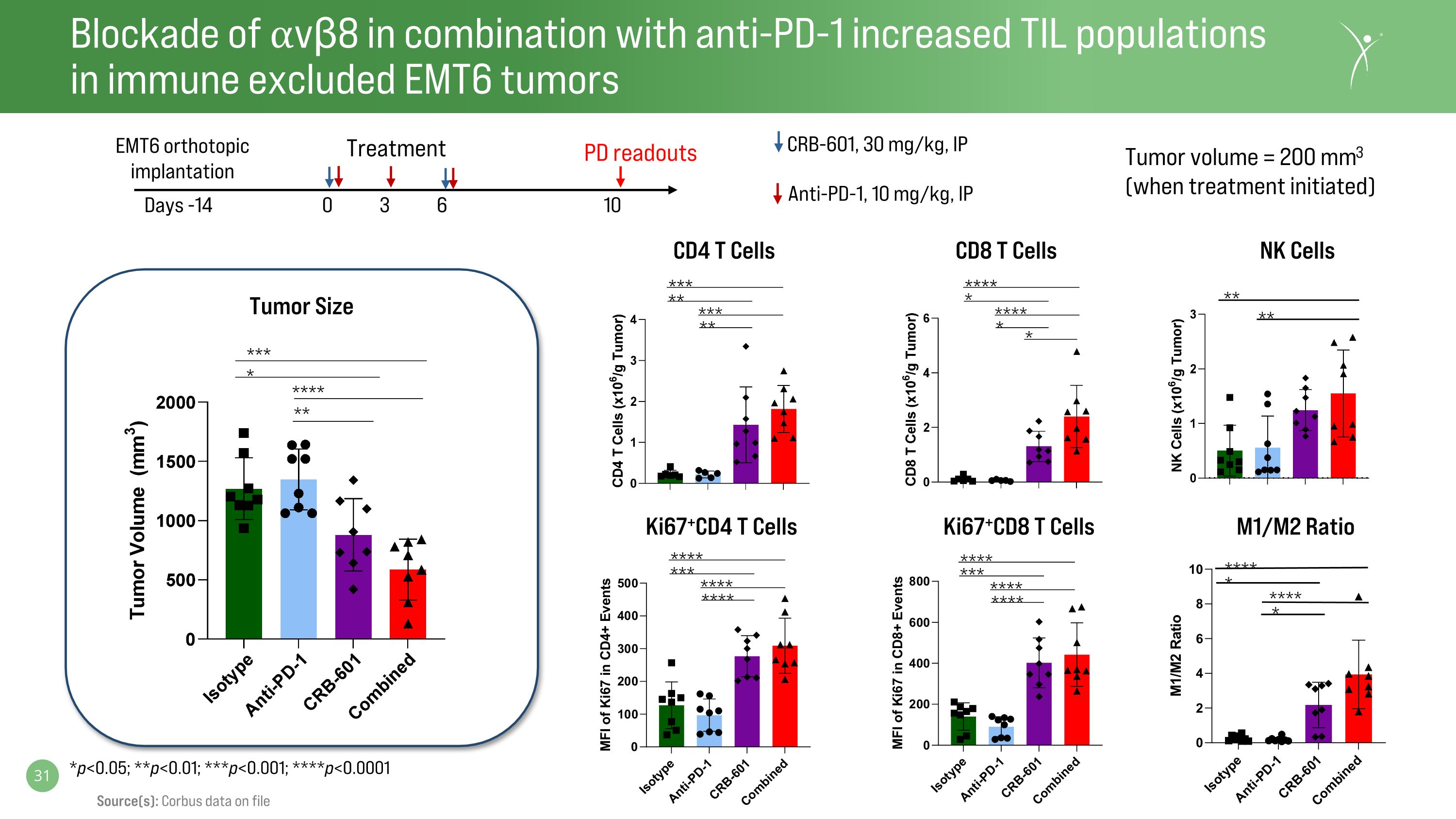
Blockade of ⍺vβ8 in combination with anti-PD-1 increased TIL populations in immune excluded EMT6 tumors **** *** **** **** **** *** **** **** Ki67+CD4 T Cells Ki67+CD8 T Cells CD4 T Cells CD8 T Cells Tumor Size * *** * **** ** *** ** *** ** **** * **** * Treatment Days -14 0 3 6 10 Anti-PD-1, 10 mg/kg, IP CRB-601, 30 mg/kg, IP EMT6 orthotopic implantation PD readouts Tumor volume = 200 mm3 (when treatment initiated) *p<0.05; **p<0.01; ***p<0.001; ****p<0.0001 M1/M2 Ratio NK Cells ** ** **** **** * * Source(s): Corbus data on file
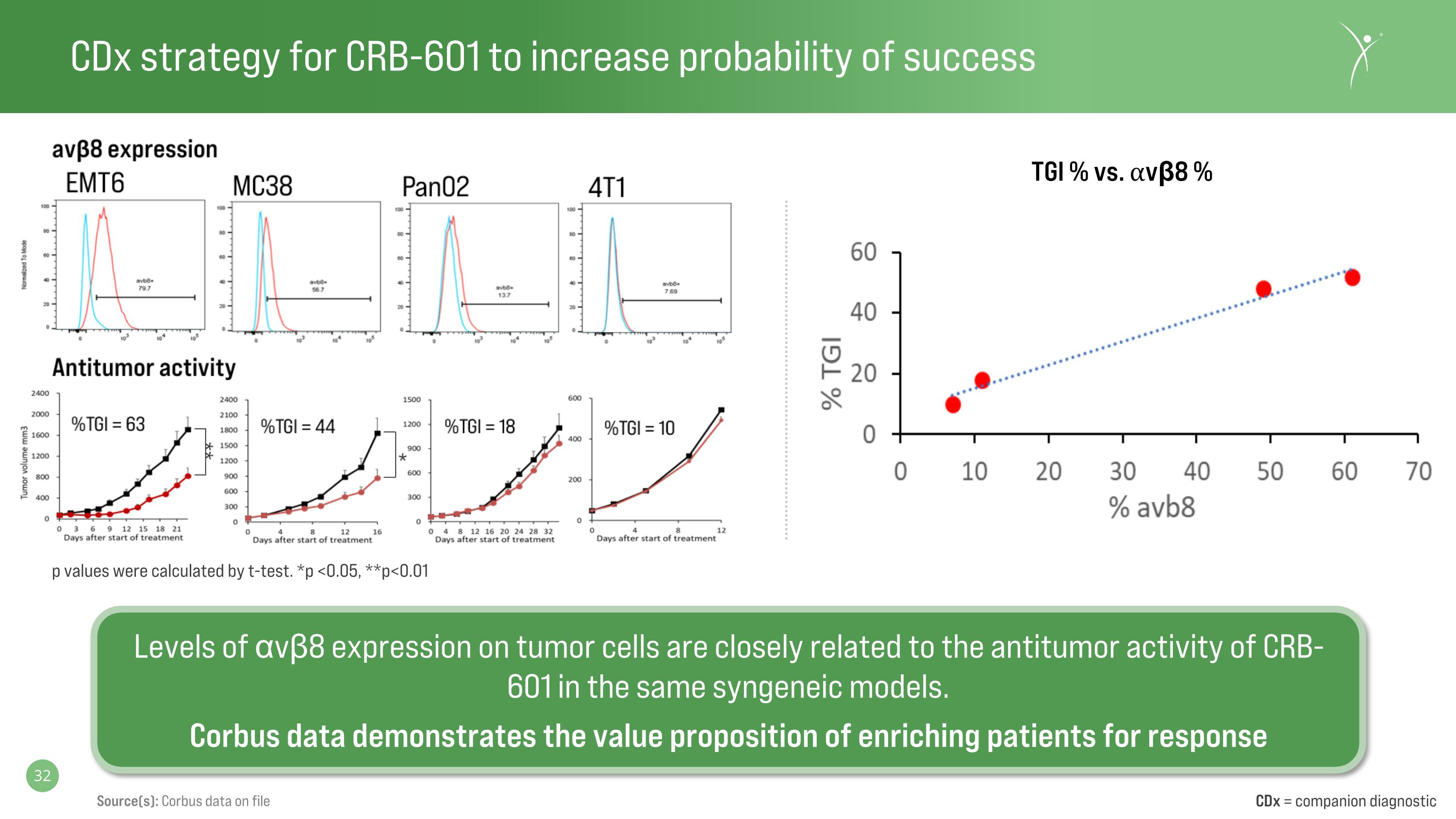
Levels of αvβ8 expression on tumor cells are closely related to the antitumor activity of CRB-601 in the same syngeneic models. Corbus data demonstrates the value proposition of enriching patients for response CDx strategy for CRB-601 to increase probability of success Source(s): Corbus data on file CDx = companion diagnostic p values were calculated by t-test. *p <0.05, **p<0.01 TGI % vs. ⍺vβ8 %
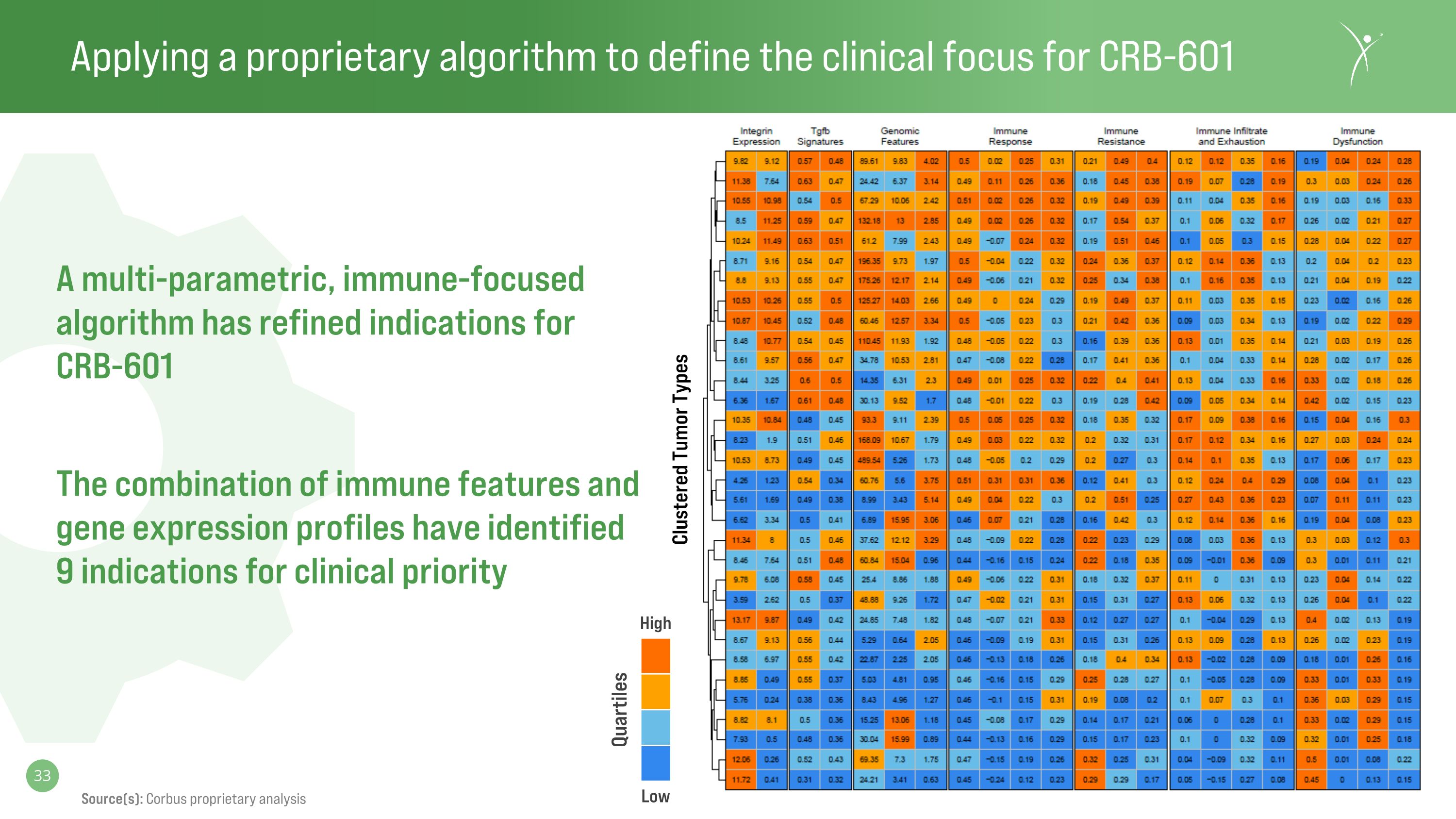
Applying a proprietary algorithm to define the clinical focus for CRB-601 A multi-parametric, immune-focused algorithm has refined indications for CRB-601 The combination of immune features and gene expression profiles have identified 9 indications for clinical priority High Low Quartiles Source(s): Corbus proprietary analysis Clustered Tumor Types
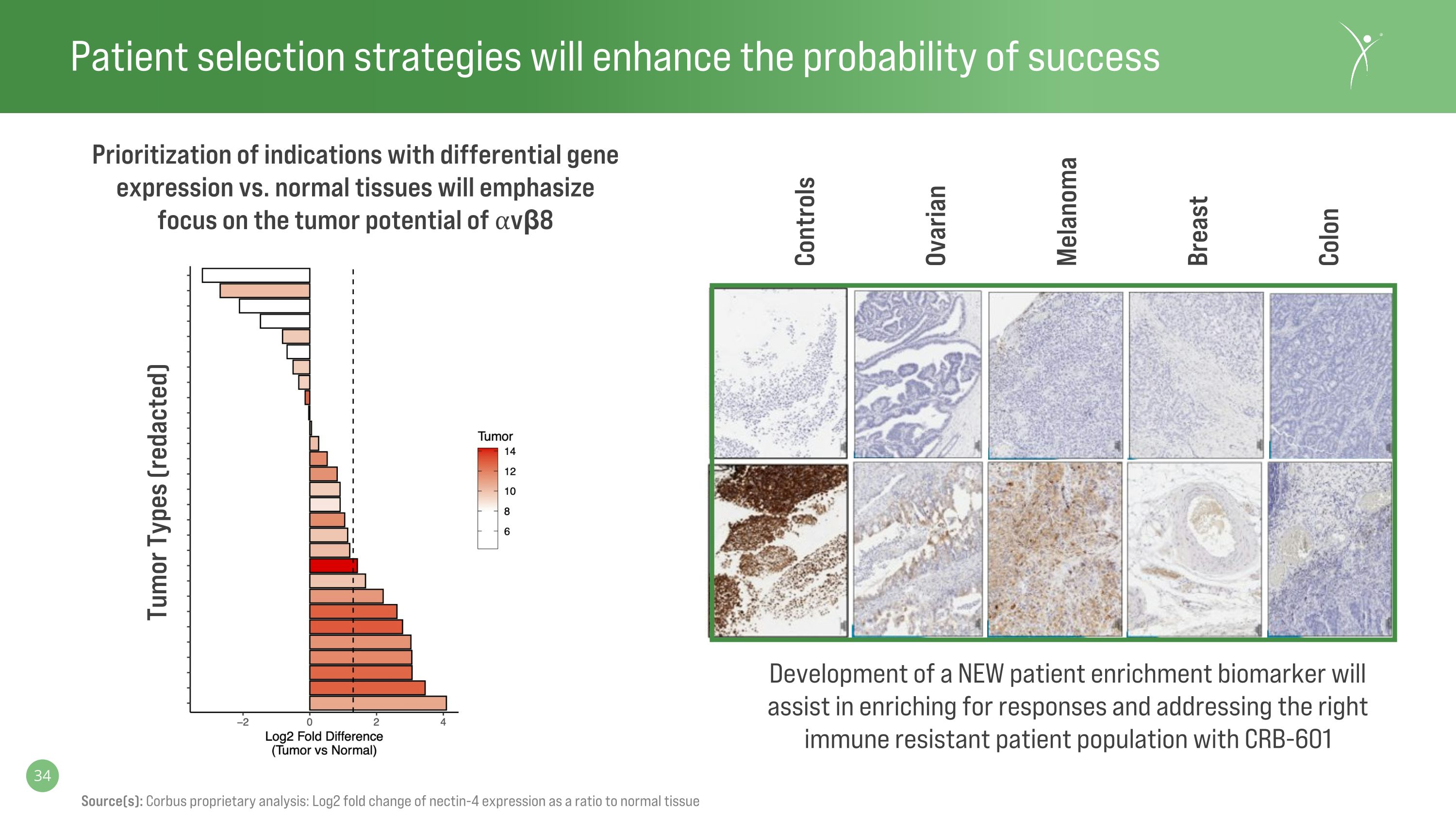
Patient selection strategies will enhance the probability of success Source(s): Corbus proprietary analysis: Log2 fold change of nectin-4 expression as a ratio to normal tissue Controls Ovarian Melanoma Breast Colon Prioritization of indications with differential gene expression vs. normal tissues will emphasize focus on the tumor potential of ⍺vβ8 Development of a NEW patient enrichment biomarker will assist in enriching for responses and addressing the right immune resistant patient population with CRB-601 Tumor Types (redacted)

CRB-601 Next Steps IND filing scheduled for H2-2023 FPI expected before the end of 2023 Non-clinical validation of a potential patient selection biomarker in 2023 Dose escalation and confirmation will be the focus through 2024

Upcoming catalysts
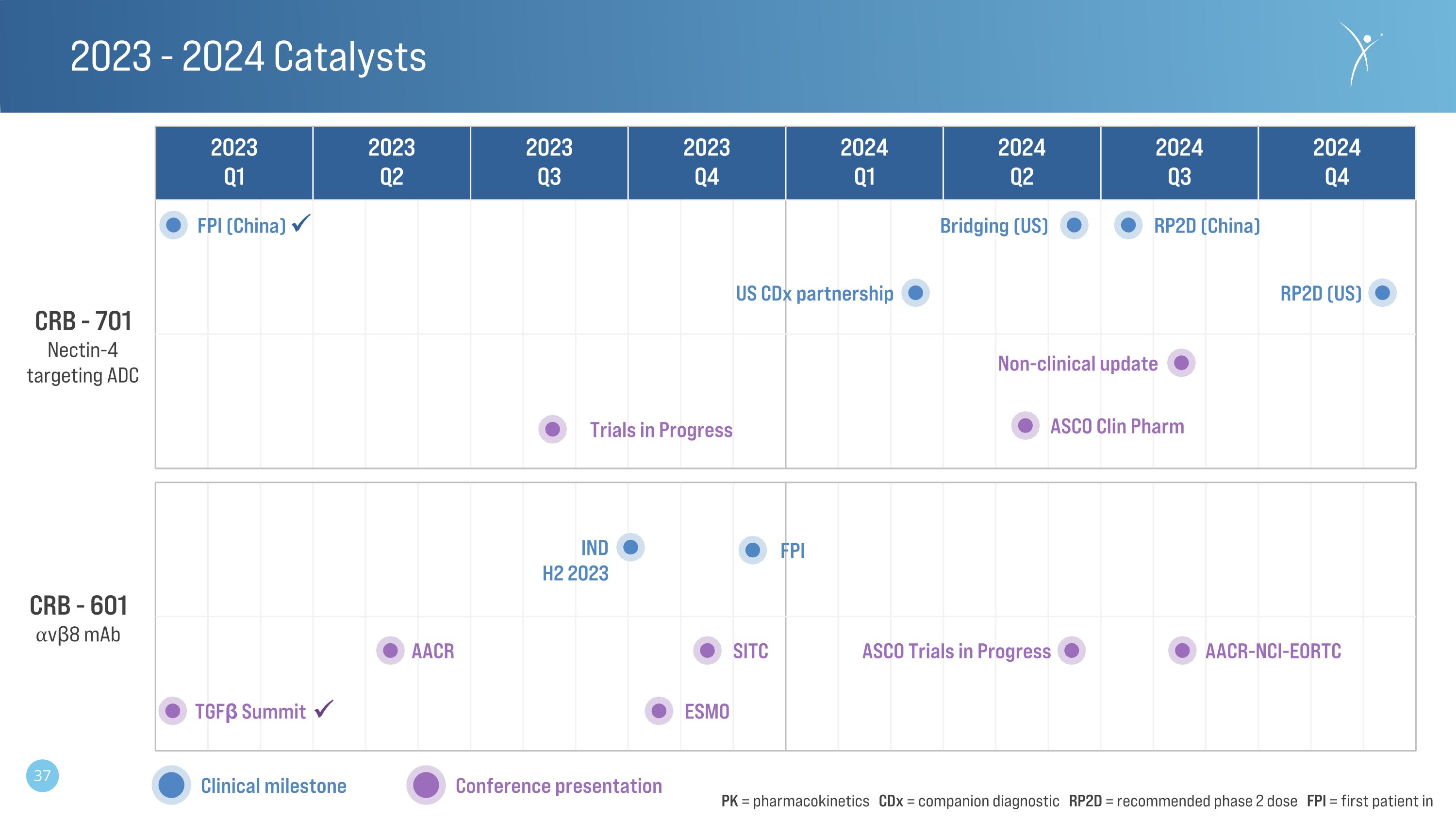
2023 - 2024 Catalysts 2023 Q1 2023 Q2 2023 Q3 2023 Q4 2024 Q1 2024 Q2 2024 Q3 2024 Q4 CRB - 601 ⍺vβ8 mAb CRB - 701 Nectin-4 targeting ADC FPI (China) RP2D (China) RP2D (US) US CDx partnership IND H2 2023 FPI AACR-NCI-EORTC ASCO Clin Pharm TGFβ Summit Trials in Progress AACR ESMO ASCO Trials in Progress Bridging (US) Conference presentation Clinical milestone SITC Non-clinical update PK = pharmacokinetics CDx = companion diagnostic RP2D = recommended phase 2 dose FPI = first patient in

Leadership

Management Team Yuval Cohen, PhD Chief Executive Officer, Director Corbus co-founder and Chief Executive Officer since 2014. Previously the President and co-founder of Celsus Therapeutics from 2005 Sean Moran, CPA, MBA Chief Financial Officer Corbus co-founder and Chief Financial Officer since 2014. Prior senior financial management experience in emerging biotech and medical device companies. Craig Millian, MBA Chief Operating Officer Experience leading commercial organizations and building successful brands at multiple biopharma companies Rachael Brake, PhD Chief Scientific Officer Expert in developing and executing innovative drug discovery and clinical development oncology programs at several leading pharmaceutical companies Christina Bertsch Head of Human Resources Accomplished senior human resource executive providing strategic HR consulting services to both large and small businesses across a variety of industries
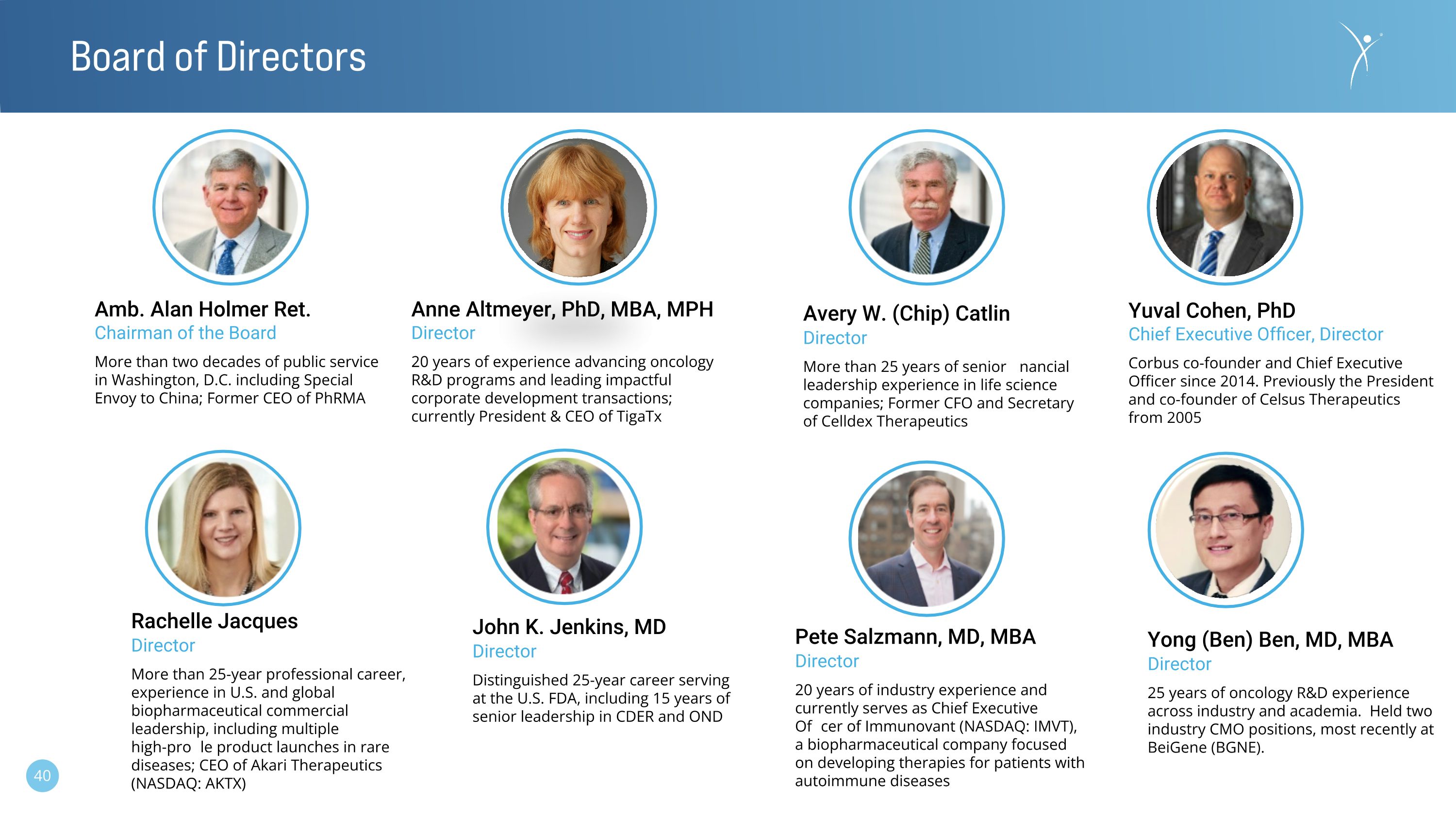
Board of Directors Amb. Alan Holmer Ret. Chairman of the Board More than two decades of public service in Washington, D.C. including Special Envoy to China; Former CEO of PhRMA Avery W. (Chip) Catlin Director More than 25 years of senior financial leadership experience in life science companies; Former CFO and Secretary of Celldex Therapeutics Yuval Cohen, PhD Chief Executive Officer, Director Corbus co-founder and Chief Executive Officer since 2014. Previously the President and co-founder of Celsus Therapeutics from 2005 Rachelle Jacques Director More than 25-year professional career, experience in U.S. and global biopharmaceutical commercial leadership, including multiple high-profile product launches in rare diseases; CEO of Akari Therapeutics (NASDAQ: AKTX) John K. Jenkins, MD Director Distinguished 25-year career serving at the U.S. FDA, including 15 years of senior leadership in CDER and OND Pete Salzmann, MD, MBA Director 20 years of industry experience and currently serves as Chief Executive Officer of Immunovant (NASDAQ: IMVT), a biopharmaceutical company focused on developing therapies for patients with autoimmune diseases Anne Altmeyer, PhD, MBA, MPH Director 20 years of experience advancing oncology R&D programs and leading impactful corporate development transactions; currently President & CEO of TigaTx Yong (Ben) Ben, MD, MBA Director 25 years of oncology R&D experience across industry and academia. Held two industry CMO positions, most recently at BeiGene (BGNE).
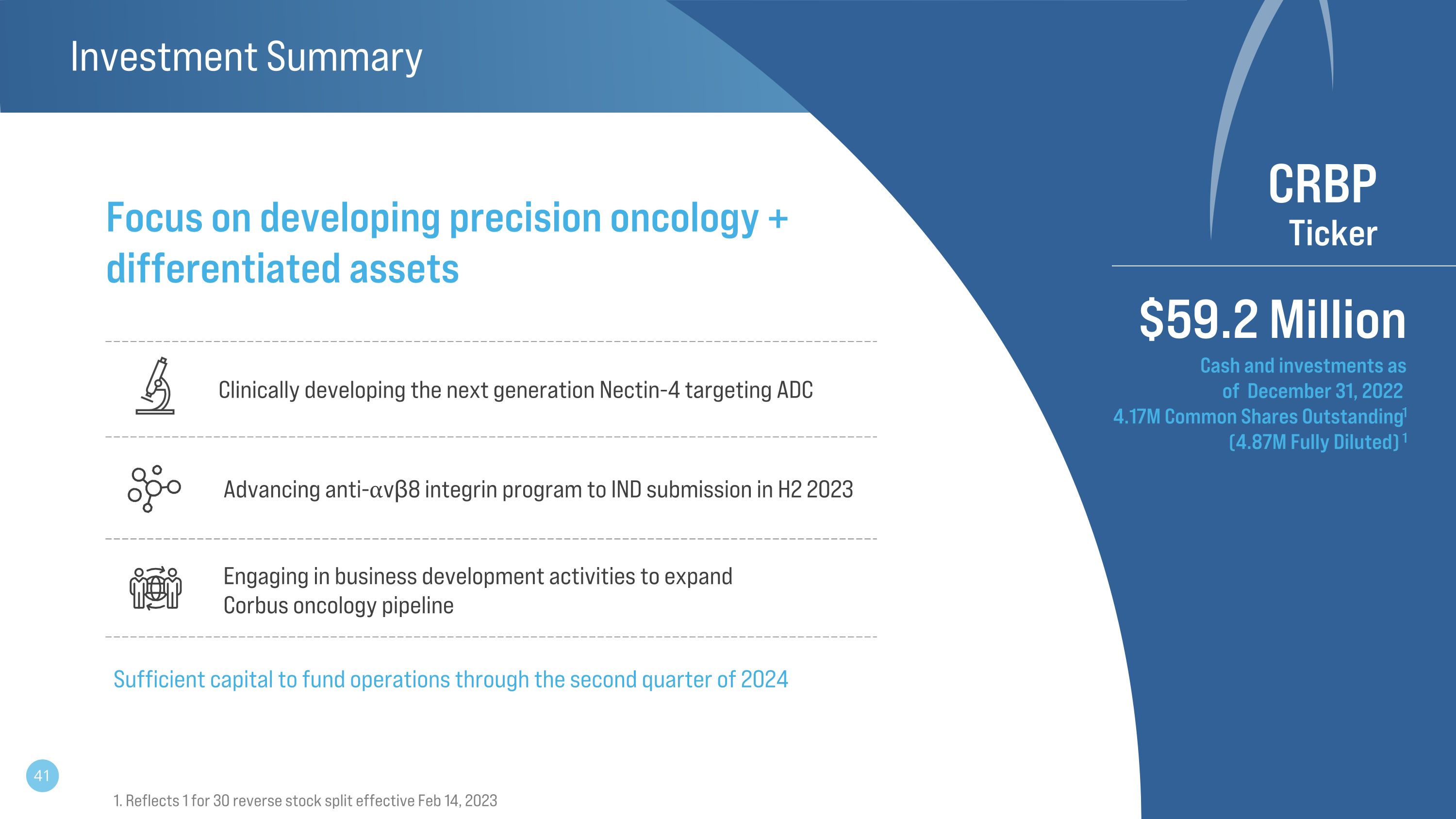
Investment Summary Advancing anti-⍺vβ8 integrin program to IND submission in H2 2023 Engaging in business development activities to expand Corbus oncology pipeline Sufficient capital to fund operations through the second quarter of 2024 CRBP Ticker $59.2 Million Cash and investments as of December 31, 2022 4.17M Common Shares Outstanding1 (4.87M Fully Diluted) 1 Focus on developing precision oncology + differentiated assets Clinically developing the next generation Nectin-4 targeting ADC 1. Reflects 1 for 30 reverse stock split effective Feb 14, 2023
